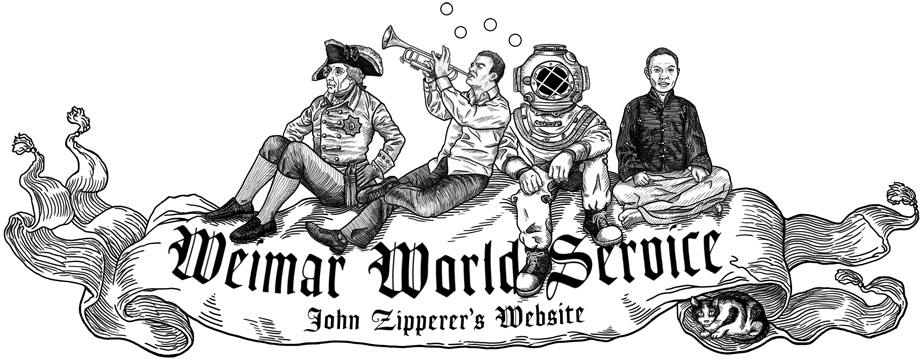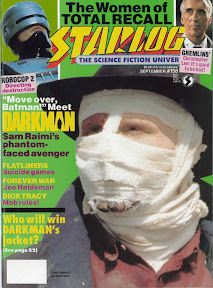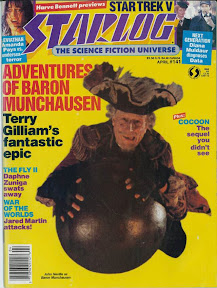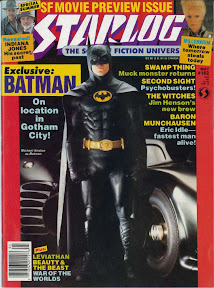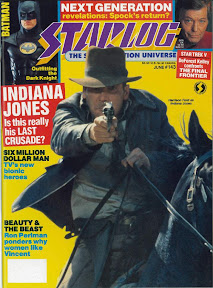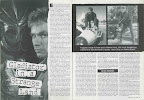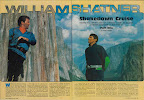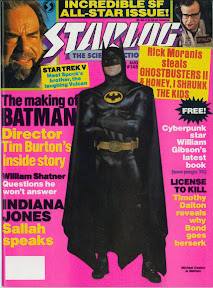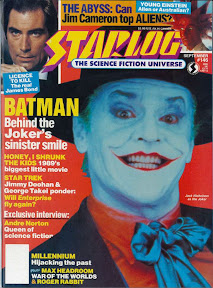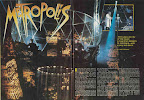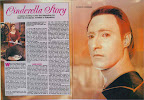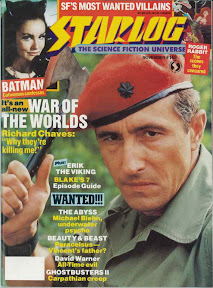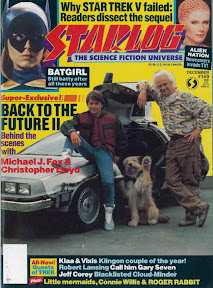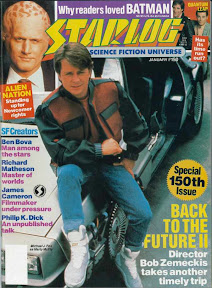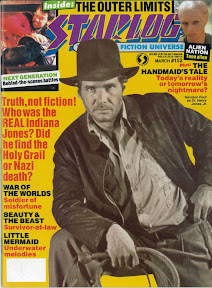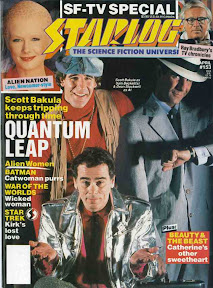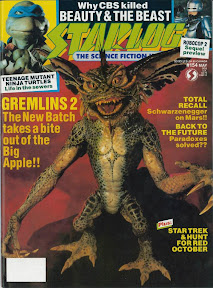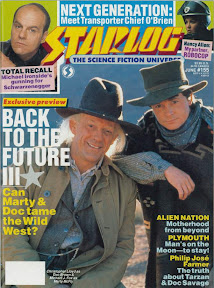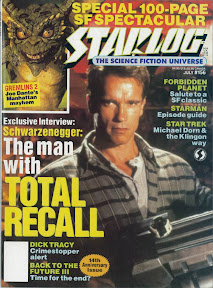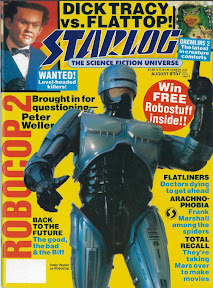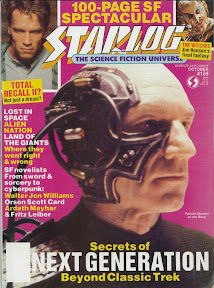| |
|
STARLOG: THE
ENTIRE RUN |
|
Starlog #141, April 1989: The Adventures of Baron Munchausen
It's a relatively quiet month at Starlog. No major revelations of staffers. No executive exits. No changes in the magazine's format. Just a typical month in the life of a science-fiction movie/TV/books magazine.
Terry Gilliam's The Adventures of Baron Munchausen is featured this month, and it's a reminder of how language can equal success. What I mean is that Munchausen was not a success, even though it's a wonderful film. Munchausen, as you might guess from the name, is based on a set of German tall tales, wild exaggerations of the baron's escapades. Though these are very well known in central Europe, they aren't as well known in the English-speaking world. Had this been The Adventures of Baron Nigel Thickelswaite of Upper Kensington Gardens, we probably would have been bombarded with the tales as kids, even though they'd have been half as interesting as Munchausen's tales.
As it is, Munchausen became another of Gilliam's well-done films that didn't find the audience it deserved. I'm at least glad Starlog thought well enough of it to put it on the cover. In this issue, editor David McDonnell says the staff actually got to see the film before its premiere, and "Munchausen has more imagination than almost any dozen fantasy films you can name combined. It's a brilliant tall tale well-told. ... Coupled with the engaging adventure of Time Bandits and the downbeat masterwork Brazil, Baron Munchausen confirms Terry Gilliam's place as one of our premier fantasy filmmakers."
Starlog #141
76 pages (including covers)
Cover price: $3.50
In staffing news, Calvin Lee is the magazine's new senior designer. He will be at the company for many years, and will do some of my favorite article designs during that time.
The rundown: That's Baron Munchausen himself (or at least actor John Neville portraying him) on the cover, riding a cannonball. Kerry O'Quinn's From the Bridge column chronicles his experience acting in a Star Trek stage play, at Gene Roddenberry's suggestion; Communications letters include an editorial note explaining O'Quinn's departure from the company the previous month (though he remains as an editorial advisor and will continue to pen his column), plus readers on various films and articles, including one who writes: "I have a challenge for Starlog Magazine. How about an issue with no articles on Star Trek?" Challenge rejected, sir! Medialog includes David McDonnell's news roundup (including the announcement that there will be a Beetlejuice cartoon series), and Ian Spelling on early word about Indiana Jones and the Last Crusade.
Marc Shapiro interviews Trek producer Harve Bennett about the upcoming Star Trek V: The Final Frontier (and Bennet says he's never watched an episode of The Next Generation, because "The Next Generation is the future and I did not want to be influenced by the future. My place is to stay home and guard what passes for the present in the Star Trek universe"); Ian Spelling profiles actor Wilford Brimley, who talks about Cocoon and its sequel; Peter Bloch-Hansen talks with War of the Worlds star Jared Martin; in Videolog, David Hutchison notes new video releases such as Predator and Big Trouble in Little China; Eric Niderost interviews actress Daphne Zuniga, who discusses her starring role in The Fly II and Spaceballs; Mark A. Altman, who would one day move into film production himself and also edit competing SF media magazine Sci-Fi Universe and briefly publishe CFQ, writes his first article for Starlog with a chat with Cocoon novelist David Saperstein; the Fan Network pages include Larry Marcheshi Jr. on the the Star Trek stage play at the Universal Pictures Tour.
Bill Warren interviews actress Diana Muldaur, the second-season (and waaay underappreciated) doctor on Star Trek: The Next Generation; in a two-page "The Guests of Trek" section, Mark Phillips profiles Celeste Yarnall ("The Apple") and Barbara Bouchet ("By Any Other Name"); Kim Howard Johnson gets Terry Gilliam's take on his new film The Adventures of Baron Munchausen; Bill Warren's three-part interview with Quatermass writer Nigel Kneale concludes; Michael McAvennie, a future Starlog staffer, interviews writer (and Starlog favorite) Peter David; in the first of a multi-part interview, Steve Swires talks with director Nathan Juran about his career, including working with Boris Karloff, the films Hellcats of the Navy, The Deadly Mantis, 20 Million Miles to Earth, The 7th Voyage of Sinbad, and more; Marc Shapiro chats with actress Amanda Pays about Leviathon and Max Headroom; and David McDonnell uses his Liner Notes column to explain whether or not a cover feature gives a film an implied endorsement of the magazine (in the case of Munchausen, he says, yes).
"This is really the same old rubbish I'm always doing, fantasy and reality, or truth and reality – whatever form it takes – that which the world perceives as truth, and that which really is truth. I like the idea that a good lie is probably better than what appears to be the truth – and maybe even more truthful!"
–Terry Gilliam, director, interviewed by Kim Howard Johnson: "Terry Gilliam's Marvelous Travels & Campaigns"
|
|
Starlog #142, May 1989: Batman Arrives
In the 21st century, the talk is of the reimagined Batman starring a growling Christian Bale, taking the storyline in darker, more adult directions. Of course, those of us more than 25 years old remember that the 1989 Batman starring Michael Keaton was in fact considered to be taking the storyline in darker, more adult directions. If we keep going in this direction, in 10 years we’ll have Eli Roth’s darker, more adult Batman, in which he tortures his victims before dispatching them with a machete. Yes, Batman can always get grimmer.
Meanwhile, there’s some slight redesigning of the magazine’s departments this issue. The column names are reversed (white text against a black background) and a border outlines the pages. It’s part of a rolling redesign the magazine would undergo with art director Jim McLernan and senior designer Calvin Lee. Soon we’ll see them turn their attention to the contents page.
Starlog #142
76 pages (including covers)
Cover price: $3.50
Classified ad of note this month: “GALACTIC TREKFEST Apr 21-23 ‘89 GOH are Richard Hatch, Bill Mumy, Merritt Butrick. Dealers, Art Show, Panels, Gaming, Banquet. Info ...”
My favorite photo caption of the issue: “Second Sight is The Three Stooges Meets Ghostbusters repaved with a little bit of Aretha Franklin’s ‘Freeway of Love’”
The rundown: Michael Keaton is on the cover, looking all tough as Batman. In his From the Bridge column, Kerry O’Quinn writes about a science-fiction/horror fan who’s trying to pursue his dream of making films; the Communications section includes reader praise for the Nigel Kneale interview, further praise for the magazine’s coverage of some classics (E.E. Doc Smith, Phantom of the Opera), news from the head of the official Martin Landau fan club, and there’s lots of reaction to TV’s War of the Worlds; the Medialog section includes Marc Shapiro reporting from the Star Trek V press conference, and David McDonnell’s roundup of genre news includes the item that Terry Gilliam is planning to direct the film version of Watchmen.
It’s Indy time, and Marc Shapiro talks with writer Jeffery Boam about Indiana Jones and the Last Crusade; Desire Gonzales interviews one-named actress Terrylene about her role in Beauty and the Beast and the challenges of working as a deaf actress; Kim Howard Johnson talks with former Python Eric Idle about his work in The Adventures of Baron Munchausen; the Fan Network pages include a collection of photos showing science-fiction characters in unexpected places, short news bits on the next Star Trek fan cruise and a video contest, and more; Will Murray previews the John Larroquette and Bronson Pinchot-starring psychic comedy Second Sight; Murray also previews Millennium; Adam Pirani goes behind the scenes of Tim Burton’s Batman.
There’s even more from Will Murray, who interviews actor Dick Durock about his work in Swamp Thing, Battlestar Galactica, and even Ewoks – The Battle for Endor; Peter Bloch-Hansen interviews actress Lynda Mason Green of War of the Worlds; Jami Bernard talks with Muppetmaster Jim Henson; Steve Swires continues his talk with director Nathan Juran (First Men on the Moon, Jack the Giant Killer, Attack of the 50 Foot Woman, and more); discount Godzillas are unveiled in David Hutchison’s Videolog column; Kim Howard Johnson checks in with director George Pan Cosmatos about his deep-sea thriller Leviathan; Starlog carries the underwater page design elements along from the Leviathan article to a Scott Lobdell article on another deep-sea thriller, Deep Star Six; and editor David McDonnell wraps it all up by discussing how and why the magazine created last month’s Baron Munchausen cover, which involved expanding a tiny image 800 percent (and which resulted in a somewhat grainy cover photo).
“George [Lucas] has made a conscious decision to keep the Indiana Jones films similar. They’re not that open-ended and I knew going into the project that I couldn’t just do anything. I think I managed to get some different things in, but I also know that George vetoed a lot of my ideas. The Indiana Jones movies use the cliffhanger serial as a role model. It’s a unique formula but, bottom line, it’s a formula which means the writer is faced with a confined structure and a series of expectations that need to be met. Fortunately for everybody involved, this formula is a highly entertaining one.”
–Jeffrey Boam, screenwriter, interviewed by Marc Shapiro: “Indiana Jones Rides Again!”
|
|
Starlog #143, June 1989: Indy Rides Again
It’s the summer of 1989, and there is a big batch of new genre films out or soon to be released: Batman, Indiana Jones and the Last Crusade, Star Trek V: The Final Frontier, The Abyss. A number of those films would become milestones in genre history. That’s not to mention many other films of this season – nor the TV series such as Star Trek: The Next Generation, Beauty and the Beast or War of the Worlds. This was really a time of growth for the science fiction and fantasy genres, and Starlog’s busy covering it all.
Oh, and get out your checkbook: They’re running a special promotion this month: Subscribe to Starlog for $34.47 and get an extra issue (13 in all!) free, or buy a gift subscription for that same price and you’ll get sent your choice of a free copy of Starlog Yearbook #5 or Starlog Poster Magazine #3 (which I take to mean that the company had extra copies of the yearbook and poster mag they were looking to unload, but it’s a good subscription premium nonetheless).
Speaking of merchandise, did you know that on page 51, you can order a Fangoria t-shirt (“Member, Fango Family”) for just $9.95? And did you know that you can't order a Starlog t-shirt, because they don’t sell any? Now, does that seem fair?
Starlog #143
76 pages (including covers)
Cover price: $3.50
This issue we get what’s essentially the last change to the magazine’s contents page. Instead of multiple photos above a listing of articles, there is now one big photo that takes up the entire page, and the departments, features, and indicia (the publication info) are printed over parts of the photo. It allows the designers to get more impact from a big photo, and they can be more flexible with the text treatment. One thing to watch out for: After a while, for some reason that I’ve never been able to fathom, the contents page stops listing the departments and will only list feature articles.
The rundown: Harrison Ford as a horse-riding Indiana Jones is the cover boy (while Sean Connery as Dr. Henry Jones is on the contents page). Kerry O’Quinn’s From the Bridge column takes a swipe at communism as it’s fading in Europe and tells people how to help give it a kick in the rear by sending SF material behind the iron curtain; Communications letters include a bumper crop of readers responding to the recent conglomeration of Klingon articles, as well as a few other (mostly Trek) articles; and David McDonnell’s Medialog includes a round-up of genre news, such as this morsel: There’s a Spaceballs sequel planned, but it’s called Spaceballs III: In Search of Spaceballs II.
Will Murray interviews actress Heather Locklear, who talks T.J. Hooker and Swamp Thing; James P. Bozikis pens an article chronicling all of the similarities between Indiana Jones and Jiminy Cricket (he’s joking, see); 25th-anniversary Doctor Who videos are highlighted in David Hutchison’s Videolog column; Edward Gross interviews actor Ron Perlman about his starring role in Beauty and the Beast; Jean Airey and Laurie Haldeman talk with John Leeson, who provided the computer voice of Doctor Who’s K-9 (which includes the tidbit that he “even managed to lose a K-9 soundalike contest”); Peter Bloch-Hansen previews The Return of the Six Million Dollar Man and the Bionic Woman II; Edward Gross checks in with Tracy Torme, creative consultant on Star Trek: The Next Generation; Bill Warren talks with another Trek figure, but one who wouldn’t join that franchise for many years: Robert Picardo, here best known for appearing in Explorers, The Wonder Years, Innerspace, Legend, and more.
Kathryn M. Drennan checks in with DeForest Kelley about his role in the fifth Star Trek film (and he also comments on his cameo in the premier episode of Star Trek: The Next Generation); Robert Watts, producer of Indiana Jones and the Last Crusade, is interviewed by Marc Shapiro (and the article includes this bit: “The third film won’t end with Indiana Jones settling down in the suburbs with a wife and kids.” No, that comes in the fourth movie); costuming maven John L. Flynn explores the world of science-fiction fandom costumes; in fact, it’s a veritable constuming special issue, what with the Fan Network pages largely given over to Crystal Wood’s article on “10 Steps to a Winning Costume”; and don’t leave out James E. Brooks’ article going behind the scenes on the designs for Star Trek movies, including a sidebar on making your own Starfleet uniform; and there’s yet more! Adam Pirani profiles costume designer Bob Ringwood, who talks about the costumes for the new Batman film, plus Dune, Solarbabies, and more; and David McDonnell’s Liner Notes column talks about his Indiana Jones hat.
“I had played beasts prior to this. This is not only a beast, but a beast who lived as an extension of his pain every moment of every day, and all of that was there in the relationship with this woman who opened up all of these new feelings in him. It was just mind-blowing that somebody could come up with a character that crystallized all of the beasts which had ever been written in history, including the Hunchback of Notre Dame, the beast from the Cocteau film and the beast that I played in Name of the Rose. These guys, I always felt, had tremendous feelings underneath their ugliness and those things were always touched on by the other characterizations, but never as articulately as in this version. I just saw an incredible sensitivity on the part of the writer for this man’s pain and his ability to transcend it.”
–Ron Perlman, actor, interviewed by Edward Gross: “Ron Perlman: Prince of the Underground City”
|
|
Starlog #144, July 1989: Shatnerized
It’s the magazine’s anniversary again, and Starlog celebrates its 13th birthday with a thick issue full of interesting articles. Not only is the cover taken over by William Shatner, but the man was busy taking over the Star Trek film franchise itself, as he checks in on his feature directorial debut, Star Trek V: The Final Frontier.
In staffing news, Eddie Bergana and Daniel Dickholtz, who had previously shared the title of associate editor, now share the title of managing editor. And remember that weird title “advertising design” from a few issues ago? No longer exists. Meanwhile, the company’s publishing efforts continue to expand, with the launch of All-Star Action Heroes, covering action films and including four posters. The debut issue includes an interview with Mel Gibson that is actually safe for kids to read.
This issue is the first to carry a $4.95 cover price (last year’s 100-page anniversary issue was $3.95). The regular-sized issues will increase in price to $3.95 next issue. It’s of course quaint to realize that a 100-page science-fiction magazine that cost $4.95 in A.D. 2010 would be a steal, but then one realizes that this was 21 years ago, that age is catching up with you, and you burst into tears. Which is appropriate for a birthday issue. So what do the editors have in store for their sweet 13th?
Starlog #144
100 pages (including covers)
Cover price: $4.95
I’m quite sure few people read it at the time, so its mention here is only vanity on my part. In 1989, I reviewed Star Trek V for my college newspaper, The Badger Herald. My thoughts on the movie were, of course, mixed, which made me one of the more indulgent reviewers of this film. Actually, even 21 years later, my feelings are mixed. Parts of it disappoints me as a let-down, as less than what could have been. But other parts of it are quite nicely done. Am I consistent or what?
The rundown: If I were a better host for you through this history of Starlog, I would go through each of the previous anniversary issues so I could see if the following statement were true or not, but I”m not: I think this is the first anniversary issue in which Kerry O’Quinn’s From the Bridge column is normal-sized, not a super-sized “special anniversary editorial.” Nonetheless, he goes Down Under and reports on the Aussie science-fiction scene. In Communications letters, readers write post-mortems of sorts for Captain Power and the Soldiers of the Future, and other readers write about everything from Alien Nation to Gates McFadden’s Star Trek: The Next Generation exit; and David McDonnell’s Medialog updates us on all of the science fiction and fantasy projects of mid-1989, such as which genre pictures were recognized by the Academy.
Robert Greenberger talks with Count Nikolai Tolstoy about Merlin/King Arthur stories (is this the first time Starlog has interviewed anyone with the title of “count”? Again, I’m not that nice of a host to go back and check); Peter Bloch-Hansen interviews Richard Cheeves, star of War of the Worlds; David Hutchison’s Videolog rounds up the latest genre video releases, such as Willow and The Wizard of Oz; Bill Warren interviews actor Martin Kove about the TV show Hard Time on Planet Earth; and just in case you were worried that people were beginning to think science fiction was getting waaaaay too serious, San Scapperotti goes behind the scenes to report on the Jeff Goldblum- and Geena Davis-starring oddity Earth Girls Are Easy; and the Fan Network pages include Michael McAvennie’s report on the continuing matter of Starfleet spaceship designs, plus there’s a quiz about SF movie advertising lines (and they include the Star Trek V ad showing a seat flying through space with the tagline, “Why are they putting seatbelts in theatres this summer?” which I think is a damn good advertising slogan. I mean, it’s no “In space, no one can hear you scream,” but I might have to go back and adjust my review of the movie....).
Adam Pirani interviews Alison Doody, who plays Indiana Jones’ (and Dr. Henry Jones’) sorta-Nazi, sorta-girlfriend in The Last Crusade; the Shat is back: Marc Shapiro interviews William Shatner about his Trek directorial debut, Star Trek V: The Final Frontier; Scott Bruce looks at SF-related lunchboxes; Adam Pirani interviews Batman co-star Kim Basinger; Kim Howard Johnson previews the Terry Jones film The Saga of Erik the Viking; David Hutchison talks with Who Framed Roger Rabbit (and really Who Censored Roger Rabbit?) creator Gary Wolf and others involved in the movie version; interplanetary correspondent Michael Wolff (with illustrations by George Kochell) takes a look at genre stories of shrinking people.
Lynne Stephens profiles actor john Neville about his role as Baron Munchausen; Juanita Elefante-Gordon interviews actress Sarah Sutton regarding her time playing a Doctor Who companion in the Peter Davison years; Paul Tomlinson questions Stainless Steel rat author Harry Harrison; Edward Gross talks to director Vincent McEveety about working on original Star Trek episodes such as “Balance of Terror,” “Dagger of the Mind,” and “Patterns of Force”; Kathryn M. Drennan pens a one-page look at actor DeForest Kelley’s career in Western films; and David McDonnell’s Liner Notes explains why the magazine is publishing David Hutchison’s many-part article on the special effects of Roger Rabbit.
“There were some cast members who had expressed their apprehension about what I would do. But I knew what I wanted from certain actors and did my damndest to get it. Despite any fears the cast may have had, they were totally cooperative. As the movie progressed, they saw that I did know what I was doing, and I think I turned those people around who had previously doubted my ability to direct.”
–William Shatner, actor/director, interviewed by Marc Shapiro: “Shakedown Cruise, Part One”
|
|
Starlog #145, August 1989: Batman in Pink
The garish pink cover must have worked so well the last time Starlog used it that it's back, this time serving as the background for a decidedly dark and sort of aggressive-looking Batman.
But with this issue, we're clearly in the Age of Batman (circa Tim Burton), so get used to seeing him or his colleagues on the cover and heavily featured inside for the next few issues. And years.
As noted last issue, Starlog #145 sees the regular cover price leap from $3.50 to $3.95. The number of pages, amount of color, and quality of the paper remains the same.
Starlog #145
76 pages (including covers)
Cover price: $3.95
In an off-handed way, former publisher Kerry O'Quinn tells us that several years previously, he was given the green light to create a science-fiction anthology series for HBO. Like many (most, I assume) series plans, it never came to fruition, but in this issue he tells about how one of the stories from the series – an original Isaac Asimov story called "Teach 109" – had recently been made into a 30-minute short film. It was probably a bitter-sweet moment for O'Quinn: he didn't get to make that story into an episode of his series, yet his natural pleasure in seeing creative people succeed gets combined with the very positive reactions the short film gets from people in the industry.
The rundown: Michael Keaton's Batman is on the cover, looking pretty in pink. Also, this issue's contents page omits listing the departments and only lists the feature articles (against a dark background shot of Keaton's Batman). In his From the Bridge column, Kerry O'Quinn explains the genesis of the short film "Teach 109"; Communications letters cover everything from Star Trek to Doctor Who ... to Star Trek; David McDonnell notes the signing of Peter Weller to star in Roger Corman's Frankenstein Unbound, and other genre news, in Medialog.
It might be the Year of Batman, but it's also the Year of Star Trek V, and Starlog will be publishing the official, licensed movie magazine for William Shatner's feature directing debut, so they've got lots of access to the creators and actors to dole out every issue of Starlog. This issue, Marc Shapiro profiles actor Laurence Luckinbill, who plays Spock's odd half-brother; meanwhile, animated Star Trek episodes are being released on video, as David Hutchison notes in his Videolog column; in the second part of Marc Shapiro's interview with William Shatner, the director dodges questions about T.J. Hooker and Kingdom of the Spiders ("What can I say? Let's talk about Star Trek some more"); Kris Gilpin previews director Stuart Gordon's Robot Jox (sort of a very low-budget, live-action American Gundam); Dan Yakir talks with James Bond star Timothy Dalton; the Fan Network pages include winners of the magazine's Batman contest, plus a short item on Bat merchandising, convention listings, and more.
Jami Bernard interviews actor/comedian Rick Moranis about Honey, I Shrunk the Kids (co-written by former Starlog and Future Life staffer Ed Naha), Spaceballs, and Ghostbusters; Adam Pirani profiles Batman director Tim Burton; Peter Orr does a Q&A with cyberpunk author William Gibson, whose newest book, Mona Lisa Overdrive, is being given away to 50 lucky readers; Will Murray interviews actor John Rhys-Davies about his work in Indiana Jones and the Last Crusade; Lee Goldberg talks with actor David Hedison about Voyage to the Bottom of the Sea and James Bond films (in which he plays Felix Leiter); in the second part of David Hutchison's multi-part look at the special effects of Who Framed Roger Rabbit, we learn about the staging of the dueling ducks Daffy and Donald, and about Baby Herman; Bill Warren looks at the preproduction art of designer Ron Cobb for James Cameron's film The Abyss; and in his Liner Notes column, David McDonnell praises the magazine design work of Jim McLernon and Calvin Lee, both of whom are also on display in person in the Fan Network pages, where they are shown with two other staffers sporting Batman clothing (with Lee wearing a cowl).
"When I first saw [Clive Barker's] Books of Blood, I thought, 'Here's a guy coming from left field.' In those stories, you can feel him getting down in the basement of the generic form and kicking the s--t out of the foundations. [Laughs]. You can see Barker figuring out what horror stories do. Regular American horror fiction never made it for me. So many of the stories are structured like dirty jokes, you know, with the revelation of obscenity at the end. Those writers are so coy, with that deliberate and sometimes totally false naivete about the stories' sexual underpinnings, whereas Barker seems totally conscious of it. He forges ahead with the sexual material. It's interesting, but I wonder what effect it has had on the genre consumer, the guy who walks into the bookstore and says, 'Gimme the next third-rate Stephen King clone.'"
–William Gibson, author, interviewed by Peter Orr: "William Gibson, Neuromantic"
|
|
Starlog #146, September 1989: The Year of Batman
For the second issue in a row, Tim Burton’s Batman is on the cover of Starlog.
For those of you keeping track of the Starlog family of publications, the company has produced the first edition of its Comics Scene Spectacular magazine, featuring guess what on the cover? Yup, Batman. It’s also been busy with its Starlog Poster Magazine line; according to the ad in the Starlog Trading Post ads, that publication is currently up to the second issue of the second series (so, #10 overall). And the Starlog Yearbook (which apparently is published twice a year, so what’s in a name?) is up to its fourth issue. Mind you, all of these magazines were put out by the same small staff that produces Starlog each month, plus four issues each year of the Star Trek: The Next Generation Magazine.
Starlog #146
76 pages (including covers)
Cover price: $3.95
Photo caption of the month: “In reality, Einstein did know Marie Curie (Odile le Clezio), but they weren’t an item.”
The rundown: Jack Nicholson’s Joker is the cover boy; a scene from James Cameron’s The Abyss is featured on the contents page (which again, alas, doesn’t list departments, only the feature articles; this is kind of the contents page for Unclear-on-the-Concept contents page designers). In his From the Bridge column, Kerry O’Quinn visits the Smithsonian Air & Space Museum; Communications letters include a call to save TV’s Beauty and the Beast (it seems that sooner or later, just about every science-fiction TV series ends up with fans pleading for the show to be saved), defense of Wesley Crusher, thoughts on why Blake’s 7 is a cult classic, and more; in his Medialog column, David McDonnell reports the exit from Star Trek: The Next Generation of Diana Muldaur, and her replacement by the person she had replaced, Gates McFadden.
Years before Yahoo became synonymous with searching the World Wide Web, people across the nation were terrorized by the word Yahoo because it probably meant they were about to be subjected to a comedian called Yahoo Serious. Scott Lobdell interviews Yahoo about his movie Young Einstein. Speaking of comedians of disputed success, Bill & Ted are back to pester audiences with the video release of Bill & Ted’s Excellent Adventure, according to David Hutchison’s Videolog column, which also notes other recent releases; Will Murray talks with director Michael Anderson about his film Millennium; former staffer Robert Greenberger’s back this issue to provide answers to readers’ queries in Fan Network (such as this query, “Sometime ago, I heard rumors that the people who made Terminator were planning to make a sequel. Will it ever be made? Or another Alien?”).
Eric Niderost interviews Cesar Romero, who played The Joker in the 1960s TV series version of Batman; Nick Dudman, who performed the makeup chores for Jack Nicholson’s Joker, is interviewed by Adam Pirani (plus a sidebar on costume designer Bob Ringwood’s work on The Joker); novelist A.C. Crispin interviews Alice Mary Norton, better known as novelist Andre Norton; Iain Blair talks with director James Cameron about a little film called The Abyss; Ian Spelling profiles Max Headroom star Matt Frewer; Peter Bloch-Hansen interviews War of the Worlds star Philip Akin; Kathryn M. Drennan checks in with Star Trek actor James Doohan (who reveals that he almost signed on to be the chief engineer in Voyage to the Bottom of the Sea); Ian Spelling interviews George Takei (who admits to not watching Star Trek: The Next Generation); Lee Goldberg talks with Michael Wilson, producer/co-writer, about the latest James Bond film, Licence to Kill; in the third part of David Hutchison’s special effects report on Who Framed Roger Rabbit, we meet the animators behind the work; and in his Liner Notes column, editor David McDonnell talks about someone who’s been impersonating novelist Diane Duane.
“The basic idea hasn’t changed at all, although obviously many of the details have gradually evolved over the years in between first getting the inspiration and actually being able to get it on film. I originally conceived [The Abyss] as a story about a group of scientists in a laboratory at the bottom of the ocean, which is the sort of sci-fi idea that appeals to all kids, I suppose. But once I had arrived in Hollywood, I quickly realized that a bunch of scientists aren’t that commercial, so I changed it to a group of blue collar workers and made the whole thing much more accessible to the average man on the street.”
–James Cameron, writer/director, interviewed by Iain Blair: “Underwater in The Abyss”
|
|
Starlog #147, October 1989: When They Walked Among us
One would expect that chronicling a 20-year-old magazine would be an exercise in nostalgia, but it is usually a very personal one: I remember what I was doing, what I was going through in life, what my attitudes were, at the time I read a particular issue when it first came out.
But this issue of Starlog is a bit more like a public time capsule, mixing brand-new film and TV productions with long-ago classics and with then-alive persons (such as River Phoenix) who would not survive into the new century. It is hard to read Lynne Stephens’ article on a stage play of the German silent science-fiction classic Metropolis and not reflect on the times that created the story in the first place (and you’re helped with that thought by Stephens’ fine writing, which begins the article telling us just how filmmaker Fritz Lang was inspired to make his story). Or Bill Warren’s profile of former Tarzan actor Denny Miller takes chrononauts back to the carefree (but boring) 1950s, when the country went for a Tarzan who looked more like a surfer than a jungle man.
However, I suspect this issue will stand out for most people because of Dan Yakir’s Q&A with 19-year-old River Phoenix (then appearing in Indiana Jones and the Last Crusade), which shows the young actor – who only had another four years to live – to be a sensitive and thoughtful man. “I would just look at Harrison [Ford]: He would do stuff and I would not mimic it but interpret it younger. Mimicking is a terrible mistake that many people do when they play someone younger, or with an age difference. Mimicking doesn’t interpret true, because you can’t just edit it around.”
Starlog #147
100 pages (including covers)
Cover price: $4.95
This is another “100-page SF Spectacular” (so says the cover), and it’s a great, article-packed issue.
In some ancillary notes here, Starlog announces the debut this issue of another horror spinoff magazine, Toxic Horror. That brings to three the number of the company’s horror film magazines: Fangoria, Gorezone, and now Toxic Horror. Gorezone would last a few more years, and it retains a fan base to this day for its devotion to more independent, bloodier horror than in Fango. But Toxic Horror – which was initially edited by Bob Martin, the former Fangoria editor – would only last five issues before being killed. It was an attempt to merge filmed horror with real-life horrors and cult topics. Martin has written elsewhere of his struggle with the publishers to prevent it from being just another horror film magazine, but the company knew how to sell horror magazines, not odd hybrids, and, according to Martin, he didn’t want to work on the magazine they had forced Toxic Horror to become, so he exited. Soon, so did the whole magazine.
Why, you might ask, did Starlog publish so many horror film magazines? Yes, horror was going through a Freddy Krueger-inspired boom at the time, but it wasn’t off the charts. Judging from comments various former editors have made, the reason appears to have been a desire to soak up newsstand space, to own market share of the horror magazine market (i.e., squeeze out competitors). So the publishers weren’t terribly concerned about whether the new magazines would last 30 years; they just needed them to last long enough to send off a few of the competition. Starlog did much the same in the 1990s, when it at one point was publishing Starlog, Sci-Fi Teen, and Sci-Fi TV (which was actually quite a good magazine). Earlier, it had spun off Starlog Platinum Edition (which switched names to Science Fiction Explorer), a title that survived a couple years before dying. (It also published two boxing magazines at the same time in the early 1980s, as well as numerous wrestling magazines for decades.)
I understand the business sense of bulking up your market share to try to see off the competitors, but I also remember, each time Starlog did something like this, that I’d rather the company had bulked up Starlog itself instead of creating separate thin magazines. Make Starlog a 100-page magazine every month; even at a higher cover price, it would have been worth it, as the editors proved with 100-page special issues such as this one, #147.
Anyway, the rundown: Brent Spiner, as Data, is the cover boy; meanwhile, a different Trek takes the contents page slot, a big photo from Star Trek III showing the Enterprise burning up in the atmosphere. Communications letters include fan comments on War of the Worlds and Beauty & the Beast, reader reviews of Batman (the movie and recent articles), a complaint about Blake’s 7 coverage, and more; and David McDonnell’s Medialog column reports that former Doctor Who actor Jon Pertwee is going to star in a new science-fiction ecology-based series called Starwatch.
Continuing the mag’s Trek movie coverage, Marc Shapiro interviews actor Leonard Nimoy about The Final Frontier (“I know the question is on many people’s minds as to how much longer we can all continue to do Star Trek.... [M]ore and more people are coming up to me and saying, ‘Are all of you still alive?’”); a restored Mighty Joe Young leads off David Hutchison’s Videolog; Dan Yakir talks with actor River Phoenix about acting in Indiana Jones and the Last Crusade, plus life, vegetarianism, and society; Edward Gross profiles Star Trek writer Arthur Heinemann (“The Savage Curtain,” “The Way to Eden,” “Wink of an Eye”); in the Fan Network pages, Robert Greenberger answers readers’ queries (such as, "In an Adam West interview [issue #117], it was mentioned that he played Batman in two comedy specials. Can I have their titles and dates aired?”), photos of science-fiction actors in non-SF scenes, William S. McCullars’ short article on the location of a Klingon battle cruiser from the original Trek series, and more; I’d never heard of this production before, but Randy Quaid starred in an adaptation of Frederic Brown’s classic story “Martians Go Home,” and Marc Shapiro has an on-the-scene report.
Kerry O’Quinn’s From the Bridge column title has been, er, abridged; it is now just called Bridge, and it’s no longer anchored (I’m mixing metaphors, but what can you do?) to the front of the magazine next to the staff box; this month, Bridge carries O’Quinn’s page-and-a-half photo report on signs that incorporate science fiction names. Speaking of films I didn't remember hearing about before now, Kyle Counts reports on Martians!!! – a low-budget comedy extremely loosely tied to War of the Worlds; Craig Chrissinger profiles Star Trek: The Next Generation executive script consultant Melinda Snodgrass; actor/author Walter Koenig is still at it, making sure he has a non-Trek career, and his latest effort is starring in Moontrap, which he discusses with Marc Shapiro; in the fourth installment of David Hutchison’s extended look at the special effects of Who Framed Roger Rabbit, we learn more about shadows and dummy characters, and more; novelist A.C. Crispin continues her conversation from last issue with novelist Andre Norton, who discusses her favorite genre films, the Beastmaster film (adapted from her book, nonetheless not one of her favorite genre films), her writing topics, and more; Lynne Stephens talks with actor Brian Blessed about the stage version of the classic German silent film Metropolis (with a sidebar on Blessed’s role in the Flash Gordon film); Marc Shapiro interviews composer Danny Elfman, who talks about scoring Batman; interplanetary correspondent Michael J. Wolff gets a bit more serious this issue, with an exploration of race and racism, “Pigments of the Imagination” (illustrated by George Kochell).
Bill Warren chats with former Tarzan actor Denny Miller, who also discusses acting in V and Battlestar Galactica; Jean Airey and Laurie Haldeman, who have been extensively chronicling the British science-fiction TV series Blake’s 7 with their interviews of anyone and everyone involved with the show, here present part one of a complete episode guide to the series; Will Murray talks with author John Varley, who discusses the Millennium film, which was made from his short story “Air Raid”; Beverly M. Payton and Shelley Savren interview young actor Christopher Daniel Barnes, who played Scott Hayden in the Starman TV series; and editor David McDonnell wraps it all up with his Liner Notes column, in which he discusses Andre Norton, as well as the more serious article by Michael J. Wolff.
“It angers me that in this society we’re trained from a very young age, watching television, to swallow preconceived ideas of what is the ideal man or ideal woman. It’s prejudice, really. Many people overcome it, but so many remain oppressed if they’re not happy with their looks, if they don’t look like Robert Redford. It’s a shame, because they shouldn’t be. When I was younger, I was worried about how others viewed me and if I was good enough. I realize now that you can’t mold an image or try to be something that you are not. As far as being an actor is concerned, your work really speaks for itself.”
–River Phoenix, actor, interviewed by Dan Yakir: “A Hero By Any Other Age”
|
|
Starlog #148, November 1989: Exit Interviews
Starlog’s kind of becoming the place you go to do your exit interview when your character is killed off in a science-fiction TV series. Denise Crosby had her pre-, post- and follow-up exit interviews with Starlog when her Tasha Yar character was murdered in Star Trek: The Next Generation, and she even got a cover story out of one of those interviews.
This month, it’s Richard Chaves’ time to pick up his final paycheck and his accumulated vacation balance, chat with the HR lady, and then carry his box of belongings out to the car. Chaves’ character, Lt. Colonel Ironhorse, was killed off for the second season of TV’s syndicated War of the Worlds program. He checks in this month – with a cover story – to talk about his character, the show, and his career. The magazine also interviews the program's producers, who explain why the changes were made.
Starlog #148
76 pages (including covers)
Cover price: $3.95
The letters to the editor this issue almost go meta on the whole Star Trek matter. Does Starlog cover too much Star Trek? Not enough? Readers battle back and forth, with this one having the final word: “OK, now that you have done it – a whole issue without any major Star Trek articles, bring Star Trek back to every issue. I’m sure [the reader who complained in a previous issue about too much Trek] will bronze this issue (#142), but, for me, it goes into the circular file.”
The rundown: War of the Worlds’ departing actor Richard Chaves is on the cover, along with the line, “Why they’re killing me!” Meanwhile, Tron’s David Warner is featured on the contents page. Communications letters tackle Trek, the state of non-Trek TV (apparently there is some), identify with Wil Wheaton, and more; and David McDonnell’s Medialog reports the latest genre news headlines, including John Haymes Newton’s replacement as the star of Superboy by Gerard Christopher.
Terminator and The Abyss star Michael Biehn is interviewed by Dan Yakir and Ian Spelling, and he tells them about whether or not James Camerons sees him as an alter ego; in the Fan Network pages, Robert Greenberger answers reader queries (such as, “Where could I get a new style captain’s uniform?”), and Steve Jacobs (who I believe is one of the magazine’s typesetters – and heir to the fortune?) reports on Universal Studios’ Earthquake ride; Bill Warren talks with actor David Warner about Star Trek V: The Final Frontier, performing Shakespeare with Patrick Stewart, Time After Time, Time Bandits, and more; Edward Gross profiles actor Tony “Paracelsus” Jay from Beauty & the Beast; Kyle Counts interviews former Catwoman Julie Newmar, who discussses her long career; and Jami Bernard checks in with a very pre-Ally McBeal Peter MacNicol about his roles in Ghostbusters and Dragonslayer.
Dan Yakir interviews Robert Davi, James Bond baddie; David Hutchison’s Videolog notes the latest genre releases, including a number of classics; Peter Bloch-Hansen reports on the changes in the second season of War of the Worlds; Christopher Golden interviews writer Craig Shaw Gardner (A Difficulty with Dwarves, An Excess of Enchantents, etc.); in “Casualty of War,” Peter Bloch-Hansen talks with Richard Chaves about his honorable discharge from War of the Worlds; Jean Airey and Laurie Haldeman complete their episode guide to Blake’s 7 (the guide ends the same way the series ended: “A stunned Avon kills Blake, a real Federation officer is revealed, troops charge in, shots ring out and, of the Scorpio crew, only Avon is left standing. Encircled by black uniformed guards, Avon raises his gun, smiles eerily, and ...”); in the fifth installment of his Who Framed Roger Rabbit special effects report, David Hutchison reveals some of the scenes that did not make it into the final film; Kerry O’Quinn’s Bridge column recounts his visit to the Toronto Ad Astra 9 convention, where he was hearing very bad things about Star Trek V: The Final Frontier; Kim Howard Johnson talks to Terry Jones about The Saga of Erik the Viking; speaking of Python, David McDonnell’s Liner Notes column chats with Kim Howard Johnson about his new book, The First 200 Years of Monty Python. Read it for the George Harrison note.
“An actor prays for a kind of diplomatic immunity from outside prosecution: a director saying, ‘I want it to be this way. I don’t want you doing that.’ I want benign neglect. Ivan Reitman is a secure enough man that he let me do just about everything I wanted to, with one exception. I wanted to have a kind of an old Beatles wig and jeg-black hair, as if to say the ’60s had just now reached Carpathia, that it had taken a while, it had gone from village to village, and it was just now coming into fashion in this remote mountain area. They receive their culture like messages in a bottle. It looked like the wig was a go, and then, I’lll never know if it was a fellow cast member or what, it was cut. It was the lamest of reasons, which is why I suspect it was for another reason. Someone said, ‘Oh, everyone in this picture already has dark hair.”
–Peter MacNicol, actor, interviewed by Jami Bernard: “Who? Me a Villain?”
|
|
Starlog #149, December 1989: Back to the Back to the Future
We know from his interview with Starlog several years back that Harlan Ellison hated Back to the Future. To punish him for his troublesome relationship with the studios (such as making a submarine drop on a big-time producer’s head) (you had to be there), Hollywood decided to release Back to the Future II: The Wrath of Khan. Wait, no, it was just Back to the Future II.
You remember that movie? It was the one you sat through because you thought it’d be better than the first one, but it turned out to look like a collection of out-takes from the first Back to the Future. In short, Back to the Future II was the Star Trek V of this series. (BTTF III, however, I thought was quite enjoyable, my usual Ellison-support be damned.)
Nonetheless, Back to the Future II is given center stage this issue, while Star Trek V: The Final Frontier takes it on the chin from readers and from Starlog’s former co-publisher.
Starlog #149
76 pages (including covers)
Cover price: $3.95
Classified ad of the month: “THE FIRST STAR TREK COMMUNITY will form for mature Trekkers. Structured community life expressing core values of ST on realistic level. Responsible, self-supporting individuals send legal SASE and autobiog letter of interest to ...” Who says fans don’t have commitment anymore?
The rundown: Michael J. Fox and Christopher Lloyd are the co-cover boys this issue, heralding the second in the Back to the Future trilogy; but pre-teen girls will prefer the contents page, which features a big photo of Ariel from The Little Mermaid. The Communications section is entirely devoted to reader reactions to Star Trek V: The Final Frontier (one reader notes, “The Final Frontier is a perfect caricature, a distillation of everything that spells Star Trek to the uninitiated and the unsympathetic: camp, silliness, pseudo-science, pretentious pseudo-morality.”); and David McDonnell’s Medialog column questions whether Star Trek V killed the Trek film franchise. This might be a good issue to hide from William Shatner.
Marc Shapiro goes behind the scenes of the new Alien Nation TV series, a spinoff of the recent film of the same name; Richard Feather interviews novelist Connie Willis; Michael J. Wolff, the magazine’s interplanetary correspondent, explores movies from the sea (Creature from the Black Lagoon, Splash, etc.): “The number of legends concerning ‘sirens’ would indicate that ‘sea-faring’ nations (Greece, England, etc.) contained a greater than average number of mermen among their populations. Sinbad, Odysseus, Popeye, Nemo, Cousteau and other maritime adventurers may have been mermen or descendants of mermen” – make of that what you will.
Peter Bloch-Hansen interviews actor Robert Lansing, who portrayed Gary Seven in the original Star Trek episode “Assignment Earth” and who says of co-star Teri Garr, “She hadn’t had much experience then, but she had this kooky personality that certainly worked,” which is amusing only because in her own Starlog interview, Teri Garr pretty much straight-up expressed her disdain for the science fiction world; the only time I ever recall seeing Raggedy Ann & Andy mentioned in Starlog is in this month’s Videolog column by David Hutchison; in a recent issue of Starlog, we met Catwoman, and this time we meet Yvonne Craig, the Batgirl actress who is interviewed by Kyle Counts.
In the Fan Network pages, Peter L. Huston writes about a public television station that broadcasts episodes of Space: 1999, Laurie Morris announces the winning candidate for Klingon of the Year honors (it's Worf), and an unsigned item announces J.M. Dillard’s book Star Trek: The Lost Years; Marc Shapiro goes behind the scenes of Back to the Future III to preview the sequel; in part six of David Hutchison’s lengthy examination of the special effects of Who Framed Roger Rabbit, we learn some of the challenges that faced the filmmakers; Kathryn M. Drennan talks with actor and director Jeff Corey, who discusses what it was like to testify before the House Unamerican Activities Committee at the height of the Red Scare, and Mark Phillips contributes a sidebar on Corey’s role in the Star Trek episode “The Cloud Minders”; Edward Gross checks in with Star Trek V: The Final Frontier screenwriter David Loughery (with two sidebars: “The God Thing” and “Star Trek V: The Lost Ending”); Bill Warren checks in with actor Charles Cooper, who plays Klingon General Korrd in Star Trek V; continuing the Klingon theme, Kris Gilpin interviews actor Todd Bryant, who played Klaa in Trek V; it’s a veritable mini-Klingonpalooza, as Marc Shapiro interviews actress Spice WIlliams about portraying Trek V’s Vixis; in his Bridge column, Kerry O’Quinn continues his theme from last issue, as he finally gets to see Shatner’s Trek directorial debut and gives a mixed review of it, saying it’s not as bad as people had told him, but giving it especially harsh grades for its silly religious content; and editor David McDonnell is photographed “consulting with Weasels in Toontown” and chats/jokes about time travel in his Liner Notes column.
“In this first Back to the Future, I felt more like a tool. In this one, I feel more like an accomplice. ... In the last movie, Marty [McFly] was pretty much a victim of circumstance. He starts out that way in this one but we also discover a weakness in his personality along the way that tends to stir the pot and make things interesting. Marty has gone through enough of this traveling stuff to think that manipulating it might benefit him. He thinks that, in an innocent way, playing with time just might help him out.”
–Michael J. Fox, actor, interviewed by Marc Shapiro: “Back to the Future III”
|
|
Starlog #150, January 1990: The Big One-Five-Oh
Starlog #150 kicks off a new decade for the magazine. Consider where it’s been in the past 10 years. January 1980 was a 68-page, $1.95 publication, with the pages half-color, half black-and-white. A little-known movie called Star Trek – The Motion Picture was on the cover.
Ten years later, the magazine is not much bigger – 76 pages – but the cover price is about twice as much at $3.95. The quality of the paper looks and feels higher, though it has bobbed up and down through the preceding decade. The cover logo has shrunk dramatically. There’s a different editor, one of the publishers has left, we’ve had musical chairs of the art director (and the entire design staff), and much of the editorial staff is different, though David Hutchison remains in his slot. The Starlog Photo Guidebooks seem to be a moribund project, but the company has spread its wings in many other ways, with videos, conventions, poster magazines, licensed Star Trek: The Next Generation magazines, official film magazines, Scrapbook photo magazines, spinoffs, and much more.
The thing that probably matters most to readers, however, is the content of the magazine. I tend to like the personality (and occasional controversy) that columnists give to a magazine, and in January 1980, Starlog had personality to spare, with a whopping five columnists (Gerry Anderson, Jonathan Eberhart, David Gerrold, David Houston, and Susan Sackett), plus editorial columns by the editor and the publisher. Ten years later, the only columnist is that publisher – now former publisher – Kerry O’Quinn, plus the editor, David McDonnell. If five was too many (and it was, for a small magazine), then one is too few. The articles, and the article mix, remain strong. Old and new, television and movies and books, interviews and previews and retrospectives, episode guides and convention coverage.
What’s missing in the latter era is not just the columnists, it’s the space science (even the Future Life science section disappeared after a few years) as well as (an admittedly sometimes heavy-handed) devotion to inspiring the readers. But what hasn’t changed is an occasional inspirational piece (often by columnist O’Quinn), a dedication to genre journalism that outclasses all competition, and a willingness to court controversy when it comes, whether it’s the outspoken people it interviews or the willingness to be a bit bolder and franker than some readers would like.
But Trek.... Trek remains.
Starlog #150
76 pages (including covers)
Cover price: $3.95
This is the 150th issue of Starlog, a magazine that by most rights shouldn’t have lasted four issues, much less become the anchor for a company publishing a couple dozen titles. Unlike the 100th issue, however, this issue only trumpets its numerical significance with a cover badge and an in-passing mention in the editor’s column.
But don’t let that fool you; it’s a very strong issue, and once again it’s not the blockbuster on the cover that makes it valuable but the interviews with various creators of SF and fantasy, where writers (in particularly Ben Bova and Philip K. Dick, in a previously unpublished interview from shortly before his death) are asked intelligent questions and they’re given the space to give intelligent and sometimes extended answers. So we get Bova – a legendary presence in the writing and editing fields of science fiction – talking politics (loves missile defence, hates Walter Mondale), and Dick – a legendary and legendarily cutting-edge writer – singing the praises of the Blade Runner adaptation of his novel Do Androids Dream of Electric Sheep as well as giving great insights into his view of writing and his stories. And that doesn’t even mention the absorbing interviews with Richard Matheson, Kurt Siodmak, and the first part of the Charles H. Schneer interview.
This is what magazines do best, when they do it well. They provide the types of in-depth articles that make you put your feet up on the desk or lie down on the couch and settle in to get some great entertainment and intellectual stimulation.
So, happy 150th, Starlog.
The rundown: Michael J. Fox’s Marty McFly returns to the screen in the Back to the Future sequel, and BTTF II takes its second consecutive cover of Starlog; meanwhile, the contents page feature photo is Blade Runner’s Harrison Ford, who is described by Dick as being “fabulous ... absolutely incredible” in his role as Rick Deckard. Communications letters include a Smithsonian employee who thanks Kerry O’Quinn for his recent column on the Smithsonian National Air and Space Museum and offers some corrections to details in the column, plus readers chime in with their opinions on Batman and Indiana Jones and the Last Crusade; and David McDonnell’s Medialog column notes that Arnold Schwarzenegger is considering which of many sequels to take part in: Twins II, Commando II, Predator II, Terminator II, and Conan III. Scuttlebutt has it that he’s most keen on returning to the Conan world, with the possibility of directing (yes), and “Shwarzenegger ... calls his participation in a Terminator II unlikely.”
Edward Gross picks up from Marc Shapiro last issue and talks to Kenneth Johnson about his new TV series Alien Nation; David Hutchison’s Videolog looks at the Christmas-timed release of the Batman video; T.W. Knowles provides a QA with veteran writer Ben Bova, who talks extensively about his Kinsman series of novels (which are the books that make me a Bova reader), as well as the Star Wars missile defense concept, which he pioneered years before Reagan was taken with the idea; the Fan Network pages include Lia Pelosi’s directory of fan clubs; Gwen Lee and Doris E. Sauter interview the late Philip K. Dick; Ian Spelling talks with the multi-talented James Cameron, who looks into The Abyss;
Marc Shapiro talks with Back to the Future II director Bob Zemeckis; and in the first part of their interview, Tom Weaver and Michael Brunas are told by veteran writer Richard Matheson about one of his few arguments with a film director.
Marc Shapiro chats with Quantum Leap producer Don Bellisario; Lee Server interviews writer/director Curt Siodmak; Steve Swires chats with Ray Harryhausen’s partner, Charles H. Schneer; in his Bridge column, Kerry O’Quinn asks readers to send him their stories for a possible book about chasing your dreams; Jean Airey and Laurie Haldeman interview Terry Nation, who talks about improving science-fiction conventions; and editor David McDonnell’s Liner Notes talks about the science-fiction “creators” interviewed in this issue.
“OK, there won’t be as much sex [in Blade Runner] as I would like to see because I just never weary of sex. I think sex is really wonderful. Sex is not an integral part of the plot, unless you lump love and sex absolutely together. I mean, [Deckard] does fall in love with Rachael in the end, the replicant. And I don’t blame him, because she sure looks cute, and jeepers, I know I would like to meet her.”
–Philip K. Dick, interviewed by Gwen Lee and Dores E. Sauter: “Thinker of Antiquity”
|
|
Starlog #151, February 1990: They Kill Security Officers, Don't They?
The space-alien buddy cop story Alien Nation only lasted one year, 22 episodes, on FOX TV in 1989-90. But while it existed, it got this cover story boost from Starlog. Hey, it was this or yet another Back to the Future II cover.
This issue Starlog publishes its mandated annual postal statement of ownership and circulation. The total paid circulation for the issue closest to the statement's filing deadline is listed as 160,739 (up a bit from the previous year's 156,109 ), including the number of paid subscriptions of 8,978 (down just a smidgen from 8,993 last year).
Starlog #151
76 pages (including covers)
Cover price: $3.95
Intriguing and/or odd classified ad of the month: “PLANET OF LOVE embroidered emblems of performance art event. Send SASE ...”
Photo caption of the month: “Just before the scene with the knife, Vincent [Price] was tickling me and I was laughing, and I couldn’t stop laughing after that,” recalls Kovack of her Diary of a Madman experience.
Or wait, here’s a rather good quip from Denise Crosby in a photo caption: “If someone seriously offered me a ticket to the Moon, ... I would have to go – because there would probably be a Star Trek convention there.”
And now, the rundown: Gary Graham and Eric Pierpoint are the Alien Nation cover boys this month; meanwhile, veteran actor James Coburn takes the featured spot on the contents page. Communications letters include thoughts on Indiana Jones and the Last Crusade (including one reader from Singapore who writes, “...it suddenly struck me that this could well be the last time Harrison Ford will ever be featured on the cover of your magazine, since Indiana Jones and the Last Crusade is the last in the series...” ah, wait until next issue, my friend), plus a number of readers comment on various aspects of Trek, including one who fears that Deanna Troi’s character might be killed off; and there’s going to be a Tales from the Darkside: The Movie, based on the syndicated TV series, according to David McDonnell’s Medialog roundup of genre news.
Marc Shapiro profiles TV’s Alien Nation star Gary Graham (he plays Matthew Sikes); in some non-Alien Nation alien news, Peter Bloch-Hansen interviews actor Denis Forest, who plays a Morthren on War of the Worlds, another short-lived SF TV series; Kyle Counts interviews Land of the Giants star Gary Conway, who says, “Our show was much more visual. Star Trek tended to be very corny. It was filmed on static sets, and the FX weren’t particularly good. And the acting – talk about wooden.”; Marc Shapiro checks in with Lt. Uhura herself, Ms. Nichelle Nichols, who talks about Star Trek V: The Final Frontier and praises director William Shatner; hey, Klaatu! Laura Long interviews Billy Gray, who portrayed 13-year-old Bobby Bensen in the 1951 The Day the Earth Stood Still; the Videolog section includes an unbylined look at the science-fiction TV pilots that didn’t make it to series, plus David Hutchison’s short report on the latest video releases, such as Star Trek V: The Final Frontier.
Abbie Bernstein makes her first appearance in Starlog’s page, though today (2010) she’s a familiar name to readers of Fangoria, and here she talks with Robin of Sherwood creator Richard Carpenter; the Fan Network pages include Lia Pelosi’s directory of fan clubs and publications, while Robert Greenberger answers readers’ questions (such as, “Are there any soundtrack albums available for any Johnny Weissmuller’s Tarzan movies?”); March Shapiro talks with Back to the Future II star Michael J. Fox; in part two of Tom Waver and Michael Bruas’ interview with Richard Matheson, the legendary writer rates his Twilight Zone episodes; David McDonnell chats with actress Denise Crosby, who has bounced up since leaving Star Trek: The Next Generation, having landed a starring role in Pet Sematary; and there’s more Tom Weaver, who also provides a Q&A with Nancy Kovack, actress in such films as Jason and the Argonauts, Tarzan and the Valley of Gold, and others; Lowell Goldman profiles actor James Coburn; in an abridged edition of Kerry O’Quinn’s Bridge column, the former publisher goes flying; in part two of Steve Swires’ talk with Ray Harryhausen’s filmmaking partner Charles H. Schneer, the producer explains how Jack Lemmon almost led The 3 Worlds of Gulliver; in a two-page Tribute section, Edward Gross remembers the late Marc Daniels and Gerd Oswald, Mike Clark provides the obituary for Lost in Space star Guy Williams, and Anthony Timpone says good-bye to Merritt Butrick, who died of AIDS at the age of 29; and editor David McDonnell’s Liner Notes features all of his reasons to buy various Starlog Group publications.
“Identified as a Communist before the House Un-American Activities Committee in 1951, the South African-born [director Cy] Endfield was blacklisted in Hollywood and was forced to work anonymously or pseudonymously in England, until [Charles] Schneer became the first American producer to offer him major studio employment under his own name. ‘Other American producers wouldn’t hire Cy, ... I knew he had been blacklisted, but Columbia didn’t object and I certainly didn’t. Frankly, I’m not interested in a person’s political or private life. All I care about is whether or not he knows his job. I was oblivious to everything else. There wasn’t any social message in the movie, so Endfield wasn’t going to be able to convert anybody.”
–Steve Swires, writer, “Maestro of the Magicks”
|
|
Starlog #152, March 1990: Indiana Jones and Otto Rahn
Writer Robert Dassanowsky-Harris writes an intriguing cover story this issue, “The Real Indiana Jones,” that seeks to tie the fictional film hero to real-life attempts to find holy relics. Dassanowsky-Harris identifies German Holy Grail seeker Otto Rahn as the Indy prototype. Frankly, I’d prefer that he had focused on the Rahn story, which is odd and compelling in itself, rather than try to link every character and plot development to some real-life or mythical antecedent.
Rahn was a young adventurer and author who got caught up in the romantic quest for the Grail, ended up serving the Nazi regime (which apparently was, as indicated in Raiders of the Lost Ark, really obsessed with finding religious artifacts that allegedly imparted earthly powers). He died a mysterious death, believed either to have been killed in the Nazi death machinery or to have killed himself in a bizarre religious ritual.
Yes, those Nazis were evil and vicious, but definitely not boring.
Starlog #152
76 pages (including covers)
Cover price: $3.95
Photo caption of the month: “Under Hitler’s funding, Otta Rahn may have actually been more of a Belloq than an Indiana Jones. (By the way, there are no photos of the mysterious Rahn.).’” Ah, yes, the innocent days before a Google Images search of “Otto Rahn” turns up many photos of the teutonic adventurer.
Classified ad of the month: “MOTHER TRIBBLE GIVES BIRTH to a litter of three. Send $10.00 + 3.00 s&h, check, or money order to ...”
The rundown: It’s an action-packed issue. Despite the fears of one reader last issue, Harrison Ford’s Indy is back on the cover, but this time in support of an historical article, not a movie preview or interview. (And it's still not the final Ford/Indy cover.) Another Raiders-era Indy photo is featured on the contents page. Communications letters include feedback on recent author interviews, the obligatory Star Trek letters, and more; and David McDonnell’s Medialog tells us that former Starlog staffer (and Future Life editor) Ed Naha is lined up to script Short Circuit 3, plus other news.
Peter Bloch-Hansen interviews handsome actor Adrian Paul, who joins the second season of syndicated TV series War of the Worlds; Desire Gonzales talks with Beauty and the Beast actor Jay Acovone, who starts off with, “When I heard that Linda Hamilton was leaving the show, I panicked! There goes my house!”; David Hutchison’s Videolog tells us about the latest video releases, including the final (well, so far as of 1990) Indiana Jones film, The Last Crusade; Sean Six, who portrays “Buck Francisco,” the “most restless member of an Alien Nation,” is interviewed by Marc Shapiro; the Fan Network pages include Lia Pelosi’s directory of fan clubs and publications; Kyle Counts interviews veteran TV producer Leslie Stevens about The Outer Limits and Buck Rogers in the 25th Century; Edward Gross talks to Star Trek: The Next Generation writer/producer Maurice Hurley, who notes that “Star Trek has absolute rules that cannot be broken, and nobody knows that until they get into it. It’s a problem that all writers have had for the most part”; and Ian Spelling reports on the music of The Little Mermaid, via songwriters Howard Ashman and Alan Menken.
Robert Dassanowsky-Harris’ cover story on “The Real Indiana Jones” is part historical essay, part speculative brainstorming. He spends too much time (in my humble opinion) trying to find echoes in every major character and plot development from past historical incidents or legends, and I think he just over-stretches some of the time. But the parts of the article that cover Otta Rahn are worth the price of admission – and ideally would have been the sole focus of the article. That’s because his life does echo (with darker shades) the high-flying adventuresome character of Indiana Jones, and it’s a nice real-world reminder that adventure and excitement isn’t only in movies; there are real people in the world who climb mountains, or who travel the globe searching for relics, or who go up against tremendous odds. I think every young reader (and not-so-young ones) of Starlog could take away something positive from that message. Just not the Nazism, I hope.
Jami Bernard talks with director Volker Schlondorff (is there a more German name in the universe?) about his latest effort, The Handmaid’s Tale, the adaptation of Margaret Atwood’s feminist tale; Margaret Baroski profiles The New Avengers star Gareth Hunt; T.L. Johns interviews science-fiction writer Melissa Scott (The Kindly Ones, A Choice of Destinies); Bill Warren chats with actor Rex Holman, who appeared both in an episode of the original Star Trek (“Spectre of the Gun”) and in Star Trek V: The Final Frontier, plus a sidebar by Mark Phillips checks in with actor Ron Soble, who also appeared in “The Spectre of the Gun”; in part three of his interview with Ray Harryhausen producing partner Charles H. Schneer, Steve Swires reports that Schneer nixed the idea of Arnold Schwarzenegger appearing in Clash of the Titans, thank God; in his Bridge column, Kerry O’Quinn uses his nephew to illustrate a story about overcoming fear of the future; and editor David McDonnell wraps it all up in his Liner Notes column by asking readers to tell him what they’d do if they were Starlog’s editor, plus listing winners of recent book give-aways.
“You know, when I was watching Star Trek: The Motion Picture I kept thinking to myself, ‘My, how the Klingons have changed!’ And during The Wrath of Khan, I kept thinking, ‘My, how the uniforms have changed!’ And during The Search for Spock, I kept thinking, ‘My, how Lt. Saavik has changed!’ And during The Voyage Home, I kept thinking, ‘My, how the production values have changed!’ Now during The Final Frontier, I kept thinking, ‘My, how the actors have changed!’”
–Christopher Haviland, reader, “Communications”
|
|
Starlog #153, April 1990: Quantum Leap into the 1990s
In its early years, every autumn Starlog published a science-fiction television issue, with previews of all of the genre series and specials for the fall season. That tradition died out in the early 1980s, though Starlog would continue occasionally to produce issues with heavy concentrations of TV-related articles and bill the issues as SF-TV specials.
Same with this issue, which is cover-dated April and which therefore came out in March 1990. Not exactly the beginning of the television season. Nonetheless, Starlog #153 features a show that would be iconic for many fans: Quantum Leap, starring a very pre-Star Trek Voyager Scott Bakula as a time-tripping and body-swapping hero.
Starlog #153
76 pages (including covers)
Cover price: $3.95
Odd/intriguing classified ad of the month: “SCREWED BY DWFCA? Join the national club that remembers its members! Send $5.00 to The Friends of Doctor Who, ...”
The rundown: Scott Bakula and Dean Stockwell are the Quantum Leap cover boys this month; meanwhile, the contents page image is an SF illustration by artist Darrell K. Sweet. The Communications letters include comics writer Jan Strnad writing about the MPAA and the movie ratings system, a number of readers exploring Trek-analia, and more; and David McDonnell’s Medialog column reports on Disney plans to bring Edgar Rice Burroughs’ John Carter of Mars stories to the big screen (and there’s also a photo of sometimes-genre star Sean Connery in the un-science-fiction film The Hunt for Red October, which would get its own article in a future issue, un-science-fiction-ishness and all).
Marc Shapiro interviews Alien Nation star Terri Treas; Kyle Counts profiles actress Lee Meriwether, who talks about acting as Lily Munster in The Munsters Today, as Catwoman in Batman, and as Losira in the Star Trek episode “That Which Survives” (which gets a great photo caption, commenting on her character’s ability to kill with a touch: “Meriwether as Losira from ‘That Which Survives’ will go down in Trek history as the one woman Kirk (William Shatner) didn’t want to be touched by.”); interplanetary correspondent Michael Wolff explores the implications of the Gremlins movies (with illustrations by George Kochell); Peter Bloch-Hansen talks with actress Catherine Disher, who portrays Mana in TV’s War of the Worlds; well, there might be dissension among the Doctor Who fan clubs, if the classified ads are to be believed, but the old shows continue to unspool in the video market, as David Hutchison reports in his Videolog column; and Bill Warren interviews “the man in that wonderful ice cream suit,” Ray Bradbury, who talks about USA Network’s Ray Bradbury Theater.
The Fan Network pages include Lia Pelosi’s compendium of fan organizations; Ian Spelling – who would one day write a syndicated science-fiction news column called High Trek – interviews Quantum Leap star Scott Bakula – who would one day star in Trek; Tom Weaver contributes a Q&A with actress Mala Powers, who discusses her roles in Flight of the Lost Balloon, Doomsday Machine, The Wild Wild West, and more; artist Darrell Sweet (illustrator of many genre book covers) is profiled by Erik A. Venema; Kris Gilpin checks in with actress Bibi Besch, who talks about facing The Wrath of Khan with her clueless ex; R. Erwin Kennedy reports on a stage musical version of Plan 9 from Outer Space, arguably the worst movie ever made; Jimmie Hollifield II talks with actor David Frankham about his career on screen, including Return of the Fly, Master of the World, and more; Desire Gonzales profiles actor Edward Albert (yes, the son of Eddie Albert), who discusses his role in Beauty and the Beast; Kerry O’Quinn’s column, anachronistically called From the Bridge again and not just Bridge, views the collapse of European communism through the lens of science fiction; and David McDonnell’s Liner Notes column explores his theories for why he hates making deadlines.
“I’m the most cinematic writer around – all of my short stories can be shot right off the page. If necessary, I wouldn’t do teleplays for the series, I would hand the directors the short stories and say, ‘Mark it with a red pencil.’ Each paragraph is a shot, and by the way the paragraph reads, you know whether it’s a close-up. ‘He said such-and-such-and-such’; that’s a close-up. ‘They were sitting around the room; they were discussing their problem.’ That’s a long shot, obviously. Then when someone speaks, you move in.”
–Ray Bradbury, author, interviewed by Bill Warren: “At Play in the Business of Metaphors”
|
|
Starlog #154, May 1990: The Gremlins Are Back
Anyone remember the Rave Ups song “In My Gremlin”? “Oooweeeeeyoooo-ooo.” Okay, I can’t carry a tune, but you can listen to it on this site, which I found through the difficult task of searching for “in my gremlin” and “song” on Google.
What brings that up? Because Joe Dante’s nasty little gremlins are back in Gremlins 2: The New Batch. I was never a huge fan of either film in this short-lived series, but there was an energy to them that I had to appreciate, and throwing in Christopher Lee for the sequel ups the interest level right there.
Still don't know why they were named after a car, though. I guess Pacers wouldn't have made a good movie title.
Starlog #154
76 pages (including covers)
Cover price: $3.95
Also of note this issue is the first ad for William Shatner’s book Tekwar, the first of what would become a series of novels and eventually a short-lived television series of its own. It’ll even get its own Starlog cover story, but you’ll have to wait a few years for that. Right now, we’re still in 1990, and those pesky gremlins are messin’ things up something awful.
The rundown: Joey the Gremlin is on the cover – okay, I don’t know if he’s really named Joey, but they’ve gotta have names, and Joey’s as good as any other; meanwhile, another vile creature – a teenage mutant ninja turtle – is featured on the contents page. Letters in the Communications section include lots of weepy reaction to Beauty and the Beast’s cancellation, plus some Back to the Future thoughts; and in David McDonnell’s Medialog, we get the latest speculation on the next chapters in the Star Wars saga.
Ian Spelling talks with Beauty and the Beast creator Ron Koslow about the death of his two-year-old series; Bruce Gordon follows up his article in #108, “The Other Marty McFly,” with “The Return of the Other Marty McFly; Daniel Dickholtz previews the Teenage Mutant Ninja Turtles movie with an interview with co-star Judith Hoag; novelist Lois McMaster Bujold is interviewed by Bob D. Gibson; Kyle Counts talks with actress Sally Kellerman, who talks about acting in Boris & Natasha, the live-action film adaption of the Rocky and Bullwinkle cartoons; in the Fan Network pages, Drew Bittner reports on GURPS games; and Will Murray previews Total Recall, the Arnold Schwarzenegger-Paul Verhoeven film based on Philip K. Dick’s short story, “We Can Remember It for You Wholesale.”
David Hutchison’s Videolog column reports on Millennium, Hansel and Gretel, and other new genre releases; Bill Warren checks in with an article on the sequel Gremlins 2: The New Batch; Kim Howard Johnson goes behind the scenes of RoboCop 2 and talks with producer Jon Davison, who says, ‘I swore I would not do another RoboCop picture! It’s the last thing I ever wanted to do! And, here I am!”; Peter Bloch-Hansen talks with War of the Worlds' young actress Rachel Blanchard; in one of the stranger-looking articles, Kyle Counts exposes Space Case, complete with lots of photos of giant rabbits in space suits, plus a sidebar on the film’s makeup artist, Rob Burman; and the magazine takes a biiiiig stretch with an article on The Hunt for Red October, John McTiernan’s adaptation of a Tom Clancy techno-thriller, which isn't exactly science fiction, but who's taking notes, right?; in his Bridge column, Kerry O’Quinn shares some lessons from his father’s death; and editor David McDonnell’s Liner Notes column talks about Bruce Gordon’s Mary McFly speculative article.
“When will George Lucas make the next Star Wars film? ... Until now, the ‘official’ answer was the one given by Lucas at the Starlog Salutes Star Wars convention held in May 1987. There, Lucas said that he planned to begin production on the next Star Wars film (Chapter I of the nine-part saga) by the end of the decade. He didn’t, however, specify which decade. ... Now, there’s a new ‘official’ answer. ... Lucas was again asked the inevitable question. And his reply: ‘I haven’t started thinking about the next Star Wars film. ... I probably will in the next five or six years.’”
–David McDonnell, editor, Medialog
|
|
Starlog #155, June 1990: Threepeat – Back to the Future III
Paving the way for the Matrix sequels and the final Harry Potter installments, the Back to the Future producers deliver the final two parts of their trilogy within a one-year timeframe. Back to the Future II was just on the cover of Starlog #150, and just five issues later, here’s Back to the Future III.
BTTF III is arguably the best of the trilogy. There’s less lazy pop-culture riffing and more storytelling. Plus they set the film in the old West, rather than rehashing the setting and story of the first BTTF. In this issue, writer and producer Bob Gale says, “Are we sick and tired of Back to the Future at this point? In a way, yes. But every time we look at the dailies or some great cut-together sequences, it gets everybody excited again.”
Starlog #155
76 pages (including covers)
Cover price: $3.95
This issue announces the second (and, alas, what would be the last) issue of the Starlog Science-Fiction Video Magazine. Editor David McDonnell says “We’re already at work on volume three, uhh, possibly because we prepared more special features and video reviews for #2 than we had space to print.” But there would never be a third issue. Too bad; the Starlog SF video mags were nicely done and are still enjoyable to read two decades later. Find ‘em on eBay.
Classified ad of the month: “THE OFFICIAL FURRY FOOTBAG GAMEBALL. Resembles a certain furry creature. For info send SASE to ...” Kind of funny, isn’t it, that it’s an “official” product of something it won’t even name. But perhaps I’m tribbling. I mean quibbling.
The rundown: Christopher Lloyd and Michael J. Fox share the cover for the second time in seven issues (the last time was #149); Denise Crosby, out of uniform and in a bikini, is featured on the contents page in a photo from the Seatrek Star Trek fan cruise. Communications letters include reaction to Michael Wolff’s article “Pigment of the Imagination” about racism, plus thoughts on Back to the Future II and TV’s War of the Worlds; and David McDonnell’s Medialog column backtracks on its prediction of a few issues back and announces that Arnold Schwarzenegger will indeed return to the Terminator story in James Cameron’s sequel – apparently some studio shuffling, changes in ownership to the film’s rights, and a mega-million-dollar paycheck for the future California governor changed enough minds to greenlight Terminator 2 (which, in my humble opinion, would tie with The Abyss as James Cameron’s best film).
David Hutchison previews the moon-colony film Plymouth; the Fan Network pages include a directory of fan clubs and the convention calendar (where it becomes clear that the Starlog festivals have dropped by the wayside, but the Fangoria Weekend of Horrors franchise has taken off); Marc Shapiro interviews actress Michele Scarabelli, who talks about portraying Susan Francisco in Alien Nation; in the first of a two-part interview, Will Murray asks writer Philip Jose Farmer about writing the Doc Savage novels; Marc Shapiro talks with Peter Filardi, the writer of Flatliners, a brat-pack scare flick; and Will Murray has another chat with actor Michael Ironside, who discusses his role as Richter in Total Recall, as well as acting in V, Top Gun, Watchers, and more.
David Hutchison highlights some TV shows now on video (such as The Twilight Zone and Doctor Who) in his Videolog column; Marc Shapiro visits the set of Back to the Future III; Mike Clark and Mark Phillips profile the late actor Vic Perrin about The Outer Limits; Kim Howard Johnson interviews actress Nancy Allen, who talks about RoboCop 2 and praises the script by Frank Miller and Walon Green; Mark A. Altman talks with actor Colm Meaney about his time on the Enterprise, portraying Star Trek: The Next Generation's Transporter Chief Miles O’Brien (though at this point the character didn’t yet have a first name); Bill and Jennifer Florence profile actor Paul Carr, who portrayed Lt. Lee Kelso on the original Star Trek’s second pilot, “Where No Man Has Gone Before”; there’s more Trek with Kyle Count’s interview of actor Paul Winfield, who discusses Star Trek II: The Wrath of Khan, as well as White Dog and Damnation Alley; David McDonnell and Eddie Berganza went on the Seatrek cruise of fans and Trek actors, and they came back to report on it (which I believe makes this the only issue of Starlog – and perhaps the only magazine ever – in which you can get photos of George Takei in swimming trunks and Denise Crosby in a bikini, so something for everyone); whoa! whiplash – Kerry O’Quinn’s column is called From the Bridge again, after see-saw in titles for the past few issues, but nonetheless he defends his positive approach to life from people who think his ideals are unrealistic; and David McDonnell’s Liner Notes column announces the latest issues of various publications from the Starlog family.
"Because you're on the moon, certain ideas and standards that you take for granted on Earth, change drastically here. In our first story, Cindy Pickett, who plays the lead character Addy Matthewson, the town physician, becomes pregnant by a guy who isn't really part of the town, but is one of Unidac's technical people. Immediately, we have a multi-level story situation. On one level, she's unmarried, a widow with four kids. But because it all happens here in Plymouth, her actions have implications for everybody in town: If she chooses to have her child on the Moon, the community is morally bound on some level to stay with her, because, in all likelihood, a child raised in the one-sixth gravity field of the moon can never go back to Earth. The community will be committed to the Moon; now they can never just evacuate the base and return to Earth. "
–Lee David Zlotoff, writer/director/producer, interviewed by David Hutchison: "Plymouth Adventure"
|
|
Starlog #156, July 1990: Total Recall of Total Recall
Genre fan favorite J. Michael Straczynski is writing the screenplay for the big-screen remake of the classic science-fiction film Forbidden Planet. There’s always a good reason for being skeptical about remakes, especially when the original is highly regarded. I mean, 1980’s Super Fuzz? Go ahead and remake it. Saturn 3? Make it anew! Big Trouble in Little China? Can’t do any worse. But keep your mitts off of Blade Runner, The Empire Strikes Back, and Time Bandits.
The part of this that should give one hope is that it’s Straczynski, the man behind the five-year novel-for-television Babylon 5. Based on that (hey, anyone who brings Harlan Ellison aboard as a consultant has some integrity going for him), I think people can have faith that he will not debase the story for the studios.
In this issue of Starlog, the classic original Forbidden Planet is given a three-article treatment, including an interview with the great Leslie Nielsen, star of the film. It’s a pretty fine treatment to give to a movie from the 1950s, but then again, few films from the 1950s laid the groundwork for much of the genre cinema that would follow, the way Forbidden Planet did.
Starlog #156
100 pages (including covers)
Cover price: $4.95
This 100-page, 14th anniversary issue is another example of why I liked Starlog’s 100-page special issues so much. It’s full of articles on classics (as in Forbidden Planet), recently deceased (as in Starman), and the new, such as Total Recall. That last film is another adaptation of a Philip K. Dick short story; though it was not as good or as trend-setting as Blade Runner, it was still a huge movie and one of the big ones that helped establish Arnold Schwarzenegger as a major box-office draw.
By the way, on page 88, Starlog announces that it will be publishing the official movie magazine for Total Recall.
The rundown: The Schwarzenmeister himself, Arnold, is on the cover in his Total Recall Doug Quaid guise; meanwhile, the contents page features a big photo from the upcoming Warren Beatty Dick Tracy film. Communications letters comment on Quantum Leap and Robin of Sherwood, delve into Star Trek trivia, and praise the television incarnation of Alien Nation; speaking of TV, David McDonnell’s Medialog announces a new TV series version of Harry and the Hendersons, plus other news; David Hutchison’s Videolog column gives the scoop on the video releases of the first two Back to the Future films (BTTF II is only $92.95 on VHS – yes, you read that correctly), plus others; and the Fan Network pages include an extensive list of various fan clubs and publications, plus the convention calendar.
Michael Dorn, who portrays the Klingon Worf in Star Trek: the Next Generation, tells interviewer David McDonnell that the scene with Worf having a tea party with Dr. Pulaski (in “Up the Long Ladder”) was good for developing the character’s story; Bill Warren interviews actor Leslie Nielsen, who was long known for playing serious roles (such as Commander Adams in Forbidden Planet) but who later carved out an even higher-profile career playing comedic roles; Tom and Jon Weaver share a byline for a talk with actor Richard Anderson, another Forbidden Planet veteran and later the man of authority on The Six Million Dollar Man; Lynne Stevens takes a look at Return to the Forbidden Planet, a sort-of Shakespearan stage rock musical version of the classic (so, if I were being exact, then J. Michael Straczynski’s version would really be the second remake, not the first); Marc Shapiro talks with Back to the Future III writer/producer Bob Gale; and Bill Warren interviews Gremlins-maker Joe Dante, who quips that if Gremlins was “like It’s a Wonderful Life meets The Birds,” then the sequel is “The Gremlins’ New York Adventure to be sure, and I suppose you could say it’s Executive Suite with Gremlins.”
Will Murray interviews Arnold Schwarzenegger about his role in Total Recall; a two-page photo feature highlights some of the colorful scenes from Dick Tracy; Will Murray continues his two-part interview with author Philip Jose Farmer, who explains that he contributed ideas to the original Star Trek TV series, but those ideas were never used because Gene Roddenberry judged them to be too complex for his imagined audience – a housewife in Iowa – to understand; David Hutchison visits Disney’s Splash Mountain; Kyle Counts profiles actor Miles O’Keeffe about co-starring in Tarzan, The Ape Man with Bo Derek; Charles J. Lietwiler provides a long episode guide to the short-lived Starman TV series; in his From the Bridge column, Kerry O’Quinn writes about the space documentary For All Mankind; and editor David McDonnell explores the similarities between Gilligan’s Island and Star Trek in his Liner Notes column.
“Forbidden Planet was, I think, the forerunner of all good science fiction films. It could very easily have been the pilot for Star Trek, which is intriguing, because I never was called to do a Star Trek. I know William Shatner, and Jimmy Doohan is a very dear friend of mine. I know Gene Roddenberry and have great respect for him. And if Forbidden Planet had anything to do with Star Trek, I can understand it, because Forbidden Planet still plays every year.”
–Leslie Nielsen, actor, interviewed by Bill Warren: "Tales of the Naked Planet"
|
|
Starlog #157, August 1990: Domo Arigato Mr. RoboCop 2
The Robo-gang is back for RoboCop 2, though not without qualms. Star Peter Weller dons the titular suit again, but he tells Starlog that he “had reservations about doing RoboCop 2. ... Wouldn’t I rather be in the Caribbean doing a 10-week movie, making my money, and splitting?”
Twenty years later, there are still some people in Hollywood who are ready to make another RoboCop, at least as a remake. The remake appears to be stalled at the moment, a victim of MGM’s severe financial troubles. But if you like remakes, I suppose you can rely on the fact that when Hollywood gets a bad idea in its mind, sooner or later it films it.
How a couple decades worth of achievement can change things, Part II: In this 1990 issue of Starlog, British novelist Terry Pratchett is interviewed. At that point, only a handful of his Discworld novels had been printed, but they were already popular enough for the magazine to sit him down for a good talk. However, it appears that the editors didn’t consider him to be a big enough draw in the United States to warrent even mentioning his name on the cover. Now cut to 2010, where Sir Terry Pratchett has recently served as guest editor of UK SF magazine SFX, and he is celebrated around the world for his now very lengthy list of Discworld books. It makes this 1990 interview worth tracking down. Just don’t look for it by scanning the cover blurbs.
Starlog #157
76 pages (including covers)
Cover price: $3.95
Classified ad of the month: “HOLOGRAM WRISTWATCHES Quality digital timepieces. Years warranty, specific image: eye, watchworks, skull, cat $14.95 + $3.00 S&H to ...” Well, the poor punctuation aside, it’s a good deal, considering that ten years earlier, Starlog tried selling its own branded wristwatch for $50.
The rundown: Peter Weller’s RoboCop gets his cover photo moment in the sun (looks like it was kind of literally in the sun, judging by the near-fluorescent yellow background); and the contents page is your opportunity to see John Goodman and Jeff Daniels in a scene from Arachnophobia. The Communications letters section is less than two-thirds of a page this issue, and the three lucky letter writers take issue with various comments by recent TV and film creators in interviews; and David McDonnell’s Medialog notes that Hollywood is already planning a RoboCop 3, even though RoboCop 2 “is barely in release.”
Julia Roberts announced in 2010 that she's converted to Hinduism, which is quite a switch from the spiritual implications of her 1990 movie, Flatliners, but nonetheless she is – in circa-1990 big hair – one of the brat pack stars (along with Kiefer Sutherland, Kevin Bacon, William Baldwin, and others) of this movie, which Marc Shapiro previews with a set visit; the Fan Network pages include a RoboCop contest, a directory of fan organizations and publications, and a convention calendar; Erid Niderost interviews Dick Tracy villain actor William Forsythe; David Hutchison's Videolog column notes recent genre releases, such as old Three Stooges work; Marc Shapiro travels to the Old West to talk with actor Thomas F. Wilson, who portrays Biff in the Back to the Future films; Mark Philips profiles actor Paul Comi, who guest starred on the original Star Trek as well as The Twilight Zone, Voyage to the Bottom of the Sea, and more; Marc Shapiro talks with producer Frank Marshall about Arachnophobia; and Paul Tomlinson talks with Discworld creator Terry Pratchett.
Kim Howard Johnson interviews RoboCop 2 star Peter Weller; Kyle Counts chats with My Favorite Martian star Ray Walston, who discusses his career; Will Murray visits the set of Total Recall and talks with Dutch director Paul Verhoeven; Kyle Counts interviews actor Ronny Cox, who plays the leader of Mars in Total Recall; Marc Shapiro profiles actor Scott Paulin (who portrays Red Skull in Captain America); Screenwriter Charles Haas is interviewed by Bill Warren about Gremlins 2: The New Batch; Kerry O'Quinn's From the Bridge column relates his tale of finding fellow science-fiction fans in unlikely places – including a pancake-induced friendship; and David McDonnell's Liner Notes tells us about some weddings he's attended lately, including that of Fangoria editor Tony Timpone.
“Equal Rites is where I found that you can only go so far by running from gag situation to gag situation. From Equal Rites onwards, I began to explore what I was doing. I think many readers who were attracted to the first two [Discworld novels] were a bit taken aback by Equal Rites. They liked it, but it wasn’t what they were expecting. When I got to Mort, I got it just about right. Equal Rites might be just too far off the centerline, but Mort got back to it. I found out how you do it, I was beginning to learn.”
–Terry Pratchett, author, interviewed by Paul Tomlinson: “Gag Writer”
|
|
Starlog #158, September 1990: Darkman Cometh
Does Sam Raimi have much real competition for a fan-favorite genre director? George Lucas is in the pantheon, of course, but not uncontroversially so. Same with Steven Spielberg, Christopher Nolan and others. But Raimi not only has productions that were hits, he has a list of them that were just geek-out fun favorites. The Evil Dead. The Spider-Man films. The Hercules: The Legendary Journeys and Zena: Princess Warrior TV series. And don’t forget Darkman, the Liam Neeson-starring film that came out of nowhere in 1990 to become a big hit.
What makes his fan favorites special is not just that they’re geek-bait and popular. He adds something to them that I don’t think other writers or directors would do. I’m not sure exactly what it is, but it seems something like a mixture of realism and humor and humanity that makes even a fairly standard story such as Darkman into something more, something that is remembered long after you leave the theater (or turn off the DVD player).
Raimi’s 1990 gem gets its due focus this month in Starlog.
Starlog #158
76 pages (including covers)
Cover price: $3.95
Unfortunately, there was a sequel to Darkman. There’s always a sequel.
The rundown: Liam Neeson’s bandaged Darkman face takes the cover shot this month; a Gremlin is featured on the contents page. The Communications letters include what looks like a form letter from Alien Nation actor Gary Graham calling for fans of his show to organize to save the program from its already-announced cancellation, plus other readers write in with the first salvos in the argument over what should happen in Star Trek VI, and some thoughful responses to Bruce Gordon’s article “The Return of the Other Marty McFly”; and David McDonnell’s Medialog gives the background to Alien Nation’s cancellation, involving the differing ratings expectations of the smaller Fox network vs. the Big Three.
Marc Shapiro interviews Flatliners director Joel Schumacher, who notes that it was not difficult to get stars William Baldwin, Oliver Platt, Kevin Bacon, Julia Roberts, and Kiefer Sutherland for his film: “We had people lining up around the block wanting to be in this movie”; David Hutchison’s Videolog column reports another Kevin Bacon film heading to video: Tremors; in probably the only Starlog article ever to include a photo of a cover of Playboy magazine, Marc Shapiro talks with Total Recall star Sharon Stone, who explains how Arnold Schwarzenegger “did little to cure Stone of her nervousness,” teasing her a lot – “In that jockstrap kind of world that Arnold lives in," she said, "I had become one of the guys” (maybe it was just Stockholm Syndrome); the Fan Network pages include a Darkman contest, a directory to fan organizations, and a convention calendar; Will Murray interviews another leading woman of Total Recall, Rachel Ticotin, who plays Melina in the film; and Bill Warren talks with the legendary Christopher Lee about Gremlins 2: The New Batch.
Peter Jensen contributes his first (and only?) article to Starlog with an interview with actress Frances McDormand about her role in Darkman, with a sidebar by Bill Warren talking with the film’s director, Sam Raimi; in his From the Bridge column, Kerry O’Quinn talks about Back to the Future and Total Recall, noting, “When I finish reading an SF novel, I often engage in lively discussions with friends about the book’s ideas – but when I leave most SF movies, discussion is usually limited to why I liked it and why my friends disliked it – reactions, not content.”; Kim Howard Johnson interviews RobocCop 2 director Irvin Kershner, who has little to say about his other pertinant films The Empire Strikes Back and Never Say Never Again; Jay Allen Sanford contributes his first article to Starlog with a chat with Russell Johnson, Gilligan Island’s professor and a veteran of a number of science-fiction/horror films such as It Came from Outer Space; Bill Warren profiles actor Henry Silva, who portrays a villain in Dick Tracy and who complains to Starlog about being typecast as a villain; Warren interviews another Dick Tracy villain, Pruneface – aka R.G. Armstrong; Eric Niderost talks with filmmaker Craig Baxley (I Come in Peace); novelist Joe Haldeman is interviewed by T.W. Knowles II and discusses The Forever War, The Hemingway Hoax, and more; and editor David McDonnell’s Liner Notes not only sports a photo of McDonnell with Christopher Lee, it also plugs a number of upcoming Starlog family magazines.
“The movie came from the idea of a man who can change his face to become other people. It was originally a short story I wrote, which was accepted with encouragement by friends. It segued into a longer story, and then became a story of a man who had lost his face and had to take on other faces. Then, it became the story of a man who battled criminals using this power. And then, because he lost his face, the idea of what would happen if he had a relationship before became important.”
–Sam Raimi, director, interviewed by Bill Warren: “Darkman Director”
|
|
Starlog #159, October 1990: Captain Picard's a Borg!
This autumnal 100-page special issue of Starlog is a nice time capsule of what was going on in the science fiction and fantasy worlds around October 1990. Star Trek: The Next Generation’s third season had presented some of its best work (such as “Yesterday’s Enterprise” and “The Best of Both Worlds, Part I”), and season four would continue the show’s maturation from its somewhat PC first year. A new generation of science fiction writers were making their names, including William Gibson (interviewed in Starlog #145), Terry Pratchett (interviewed in #157), and Orson Scott Card (interviewed this issue).
What was happening outside of the SF world at that time? After all, if there’s supposed to be some connection between the themes of science fiction and the real world, then there should be something of interest.
Let’s see. Soviet leader Mikhail Gorbachev got his legislature to pass laws laying the foundation for a market economy. France and England are connected by the Channel Tunnel. East Germany and West Germany are reunited after 45 years. President Bush was readying Operation Desert Storm to counter Iraq’s invasion of Kuwait in August. Akihito becomes the 125th emperor of Japan. And, perhaps most important, the Internet Movie Database is launched, ending world conflict (well, as long as that conflict revolved around trying to figure out how many Police Academy movies featured that guy who can make weird sounds with his voice). Hey, it apparently brought a East and West Germany together.
Hmm, the real and the science-fiction worlds seem to be out of sync. In the real world, nations are moving together, settling old fights, and uniting (with the exception of Iraq, though even that brought together a million nations in George Bush’s coalition to invade Iraq). But in the science-fiction world, the peaceful if bland federation is threatened by the evil Borg, and Arnold Schwarzenegger is threatened by memory control.
Or wait, maybe it’s all right after all. SF is supposed to predict the future, right, not necessarily reflect the present. So this issue of Starlog has an interview with Orson Scott Card, who presages the rise to power of anti-science conservatives who reject climate science and impose religious views on matters of individual freedom. (But hey, I’ll give him this: He’s a very good writer.)
If only we’d known ...
Starlog #159
100 pages (including cover)
Cover price: $4.95
A photo caption to make you think: “Sikes (Graham) comes to terms with his feminine side as he must help deliver George’s (Pierpoint) child.”
The rundown: Patrick Stewart hasn’t been made into a knight yet by the queen of England, but he has been made into a Borg by the Borg queen, as he models the latest in cyborg headgear on this month’s cover; meanwhile, Peter Pan gets the contents page featured photo slot. Letters to the editor in the Communications pages all explore the Back to the Future III film or respond to Bruce Gordon’s exploration of that film (and, I have to admit, some of the hypotheses they suggest are quite interesting – Starlog readers really pay attention when they see movies); in Medialog, Marc Shapiro shares Bill Cosby’s comments about his planned remake of H.G. Wells' The Man Who Could Work Miracles, and David McDonnell provides a roundup of genre news, such as reading the tea leaves indicating that a Star Trek VI will be made (because Paramount’s been shopping around merchandising opportunities to potential partners – and I’d be willing to bet $2 that one of those potential partners was licensed movie magazine publisher Starlog); the Fan Network pages include a two-page article by Bill G. Wilson about modelmaker Mark Bradley refurbishing the original Battlestar Galactica model, a Star Trek novels contest, a very brief list of Beauty & the Beast fan clubs, and a convention calendar; and David Hutchisons’ Videolog column announces the release of Peter Pan on video, pllus other news.
T. L. Johns interviews legendary SF author Fritz Leiber; Bradley H. Sinor talks with Russell Bates about the animated Star Trek; Marylois Dunn profiles author (and self-proclaimed “very mean little old lady”) Ardath Mayhar; Jim George talks with director Nicolas Roeg about his fantasy The Witches, and he also gets Roeg to comment on his David Bowie SF film The Man Who Fell to Earth and its leading man, with whom he seems to retain a cordial if distant friendship; Star Trek: The Next Generation writer/producer Michael Piller tells Edward Gross about recent episodes; Will Murray interviews Total Recall screenwriter Ron Shusett about the film, including the abortive David Cronenberg-Richard Dreyfuss version; Edward Gross gets the inside scoop on the late Alien Nation TV series from that show’s writers; in part one of a multi-part article, Mark Phillips talks to the writers of the 1960s TV series Land of the Giants; and Mike Clark interviews Shimon Wincelberg, writer for Lost in Space (and he tells us that Carroll O’Connor – who eventually starred in All in the Family – was considered to star in Lost in Space, but the actor turned it down), Time Tunnel, and more.
It's a very writers-heavy issue. W. Bradford Swift interviews Ender’s Game author Orson Scott Card, who mostly gives a standard overview of his books and writing, but who also has some typically thought-provoking comments; Kerry O’Quinn’s From the Bridge column issues a call for ideas from readers; Bradley H. Sinor talks with another novelist, Walter Jon Williams (author of Angel Station, The Crown Jewels, and more); Wanda J. Hall checks in with Star Trek novel writers Diane Carey and Greg Brodeur; in a three-page Tribute section, Adam Pirani says good-bye in obituaries for the great Jim Henson and actor David Rappaport, Tom Weaver notes the passing of actress Susan Oliver, and Eric Niderost remembers actress Jill Ireland; and editor David McDonnell wraps it all up in his Liner Notes column, telling a cute story about his younger self, a mimeograph machine, and memories.
“I’m talking about books by 35-year-old novelists writing about 35-year-old characters who nevertheless approach the world as an adolescent: that life is all about getting free of people that dominate you. That’s a 15-year-old’s viewpoint. There should be fiction that tells you about growing up, about being an adult who’s responsible, who can’t just walk away when he gets tired, who doesn’t just go and get a divorce, who doesn’t have a mid-life crisis, but instead, sticks it out and deals with what goes wrong. There aren’t many adult heroes in fiction.”
–Orson Scott Card, author, interviewed by W. Bradford Swift: “Words He Lives By”
|
|
Starlog #160, November 1990: The Flash – in a Pan
Audiences weren’t exactly enamored of the previous Flash – the Dino De Laurentiis Flash Gordon film from 1980. But 10 years later, in 1990, CBS TV aired a different comics-based hero, The Flash, as a regular series. It starred John Wesley Shipp, and noteworthy guest stars include Mark Hamill. The Flash only lasted one, 22-episode season, and in that respect it resembled various failed attempts to bring science-fiction or comics projects to the small screen in the 1970s. I’m no Flash expert or fan, but from what I gathered from listening to other folks who were Flash-ers, this series was fairly well received and appreciated by comics fans (unlike many of the cheapo 1970s productions alluded to above), if not the network.
So, short-lived but well-loved.
Meanwhile this month, in other Starlog-ish news, Lia Pelosia is now listed as a consultant, along with former publisher Kerry O’Quinn, in the staff box. Also, the company ceased publication of its Bob Martin-spawned real/reel horror magazine Toxic Horror, and one of its other horror film magazines, Gorezone, has switched from bimonthly (six times a year) to quarterly (four times annually) publication. Starlog, Fangoria, and Comics Scene are all chugging along healthily, however. And, after a couple years’ interregnum, the Starlog Festival SF conventions return, with a January 12-13, 1991 event in Anaheim, California, with appearances from Patrick Stewart (Whoopi Goldberg’s boy toy, as you’ll see), Bill Mumy, Denise Crosby, Joe Barbera, and others.
Starlog #160
76 pages (including cover)
Cover price: $3.95
Classified ad of the month: “STAR WARS Can get ya it got me good. I got over stocked with original Star Wars style A posters & Anakins U.S. $80 each ...” Oh, if only people’d pay the extra 30 cents to have correct punctuation in their ads.
The rundown: That’s John Wesley Shipp as The Flash on the cover; Kim Hunter in full Planet of the Apes get-up is on the contents page; Communications letters are overwhelmingly devoted to commenting on various Star Trek topics (such as how to defeat the Borg), with the remainder a grab bag of Land of the Giants, James Coburn, Airwolf, and Quantum Leap commenters; and David McDonnell’s Medialog includes the truly scary news that the people who brought to TV the mind-numbingly boring and annoying series thirtysomething are planning a Robin Hood movie, which (thankfully) never materialized. (For you readers too young and blessed not to have lived through an episode of thirtysomething, just know that it was the show that confirmed in the rest of the population the conviction that Baby Boomers were self-absorbed and whiny. That show, the network suits saw fit to run for four seasons. The Flash could have livened up those characters.)
“Patrick Stewart doesn’t have much hair, but, boy, is that man sexy!” – or so says Whoopi Goldberg in her interview with Marc Shapiro, in which she discusses her recurring guest star role on Star Trek: The Next Generation and her role in Ghost; David Hutchison’s Videolog column notes the release of some Woody Wookpecker cartoons, plus other genre releases; Steve Swires interviews Edward Judd, star of The Day the Earth Caught Fire and First Men in the Moon; Tom Waver and Michael Brunas do a Q&A with actress Kim Hunter about her days as an ape on the Planet of the Apes movies; Marc Shapiro talks with Alien Nation star Eric Pierpoint, who portrays detective George Francisco in that series; Shapiro also has a short talk with actress Lauren Woodlan, who portrays alien kid Emily Francisco on Alien Nation; and Frank Garci profiles actor Brian Tochi, who guest starred in the original Star Trek episode “And the Children Shall Lead” and also appeared in Space Academy, The Twilight Zone, and Teenage Mutant Ninja Turtles.
Marc Shapiro keeps giving us more this issue: he explores the new superhero TV series The Flash; the Fan Network section includes a directory of fan clubs and the convention calendar; Bill Warren previews Eve of Destruction, which stars Renee Soutendijk and Gregory Hines; in the first of a multi-part article, Edward Gross talks with veteran writer George R.R. Martin about TV’s Beauty & the Beast, about which Martin comments, “To the extent that if your ratings are strong, you earn yourself the freedom to do whatever you want. When your ratings begin to sink, and I experienced this on Twilight Zone too, suddenly you’ve got a lot of ‘help’ from the network and the studio. And it’s not necessarily the help you want. On Twilight Zone, things got so bad at the end that we had two network representatives sitting in on our story meetings. We never got that bad on Beauty & the Beast, but yes, we did go with more action in the middle of the second season and definitely in the third.”; in “Lord of Disaster,” Lowell Goldman talks with director John Guillermin about The Towering Inferno, King Kong, Sheena, and more; in part two of Mark Phillips’ talk with the writers of The Land of the Giants, future Dynasty creator Richard Shapiro notes about his involvement with Giants: “My writing career was not exactly soaring when I got my first script assignment for Giants. I needed the credit, I needed the money and frankly, I would have worked for anybody who offered to hire me.”; Kerry O’Quinn’s From the Bridge column explores his enchantment by total solar eclipses; and ye kindly editor, David McDonnell uses his Liner Notes column to – perhaps oddly, perhaps uniquely – suggest other magazines of interest (from other companies) to which Starlog readers should subscribe.
“Ah! That was great! Jonathan [Harris] and I remained friends years after the show [Space Academy]. Jonathan always had a story to tell. I would just sit with him and marvel at the stories about stage from way back and he would have them all. I remember every morning, he would bring a whole box of Tootsie Pops! He was terrific, so much fun, so clever, so witty, so much arrogance. He was testy. The first time I met him was at a doctor’s office – we were having our medical checkups for insurance purposes. In there were Pamela [Ferdin] and Jonathan Harris! I went up to him and said, ‘How do you do, I’m Brian Tochi, what’s your name?’ And he looks at me! ‘You do not know me, really?’"
–Brian Tochi, actor, interviewed by Frank Garcia: “Star Child”
|
|
|
|
